Riding the eco-tourism digital wave
From farm to fork: food innovation

What will the car of the future really look like?

Riding the eco-tourism digital wave
From farm to fork: food innovation

What will the car of the future really look like?


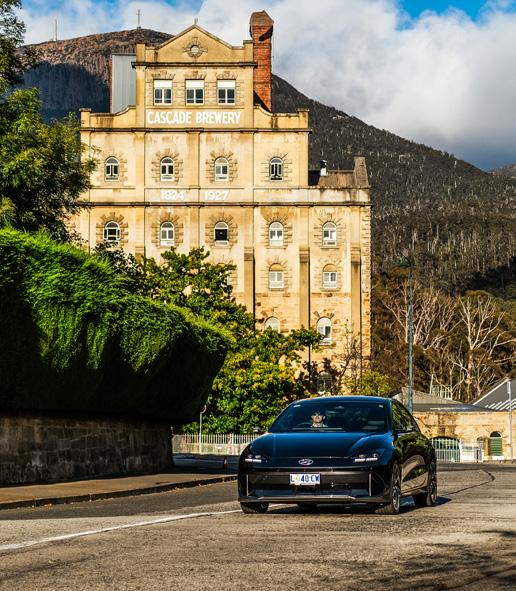

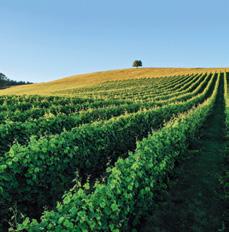


With Tasmania now in an election campaign, we’re excited to launch a nation-leading safe driving initiative aimed at creating a generation of safer drivers.
Did you know, on average, around 300 people are injured or killed on Tasmania’s roads every year? Although road fatalities in Tasmania decreased in 2023, the increase in serious injuries, particularly among young drivers, remains a major concern.
Recognising the critical role education plays in preventing road crashes, our initiative takes a holistic approach to driver education, embedding road safety education in our schools to encompass both theoretical knowledge and practical experiences. We want to cultivate responsible driving, ensuring young drivers navigate Tasmania’s roads safely and become advocates for road safety within their communities.
Without action, Tasmania faces not only the tragic reality of more deaths and serious injuries on our roads, which is estimated to cost the state on average $38M per year, but also the profound effect on hundreds of families and communities impacted by this road trauma.
As polling day approaches, we encourage all Tasmanians to ask their local candidates about their commitment to reducing road trauma by investing in meaningful solutions.
Outside of the election, we’ll be elevating our advocacy efforts with a keen focus on youth education. This means you’ll see us more often as we encourage all Tasmanians to reflect on their driving habits.
Our community team is set to be busier than ever, reaching out to schools and community groups across Tasmania. Through these interactions, we aim to instil a culture of safety and awareness among our future drivers.
Finally, reflecting on our centenary celebrations, it’s heartwarming to see the enthusiastic participation of nearly 2000 members in events across Tasmania, from community cinemas to exclusive garden parties, making it a year to remember.
As a member organisation deeply rooted in Tasmania, we’re proud of our impact on this island and our role in shaping a brighter future for upcoming generations. With 2024 full of potential, we’re excited for what lies ahead.
Thank you for your continued support.
Mark Mugnaioni // RACT Group CEOBOARD Tony Coleman, Ralph Doedens, Mark Grey, Alex McKenzie, Keryn Nylander, Jenny Richardson, Ian Gillespie RACT GROUP CEO Mark Mugnaioni JOURNEYS MANAGING EDITOR Ben Hansen

I drive a school bus, ride a motorcycle and have had a driving licence for 50 years. I see poor and dangerous driving everywhere. P-platers driving too fast and erratically, drivers not indicating, and tailgating. Authorities need to send out a severe message and follow up with penalties. For example: people caught hooning and speeding




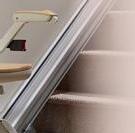




should lose their licence and vehicle. I don’t support the premise that older vehicles are unsafe. Any vehicle driven by a thoughtless, inconsiderate, impatient, egotistical driver is unsafe. Motoring standards are slipping and authorities who should be checking are either overworked or non-existent.
Nick GillThe problems with our poor road safety record are many and various. Too many drivers flout the road rules, from speeding to not signalling, signalling incorrectly, drink and drug driving, failure to give way, and many other infringements. Lowering the speed limits won’t solve these problems, it will only impact on most drivers who obey the speed limits.
Jeff Campbell // Perth


Having noticed the frequency of occurrences, have you considered lobbying government to legislate to stop smoking inside vehicles? My reasons for this are threefold. Firstly, igniting and holding a smoking device is a distraction for drivers; secondly, discarding smoking devices out of a vehicle is a bushfire hazard; and thirdly, passive smoking for others inside the vehicle is a health risk. Perhaps authorities should accept dash camera submissions for evidence in the prosecution of offenders.
Brian Hinson
Grand Central, but nothing in the block past Coles, and the next ones are obscured by trees near Jessups? This means those turning from Canning or Balfour don’t see the signs before the speed camera location. Never near Morty’s or Woollies where they can be seen. Poor form.
Brian Mitchelson
Looking back
We’re keen to hear your thoughts on any motoring or travel-related topics and auto questions. Please keep them brief – we reserve the right to edit.
Terry Lawson
Wildlife tips
After watching you on TV talking about wildlife, I use a roo shooer that’s electrically attached to my car. When switched on it’s effective to around a 1km radius. For over 10 years, it has kept wildlife away. Several of my friends have also found them to be effective.
@ractofficial Photos: IStock National Road Safety Week 2024 5-12 May 1/4 ad.indd 1



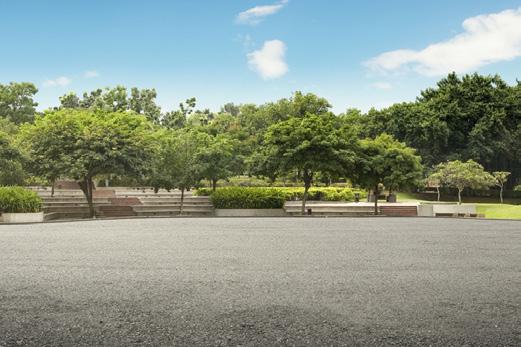
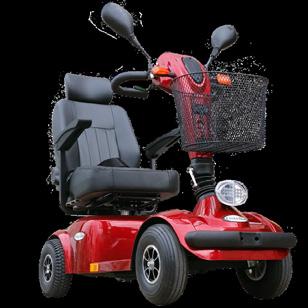




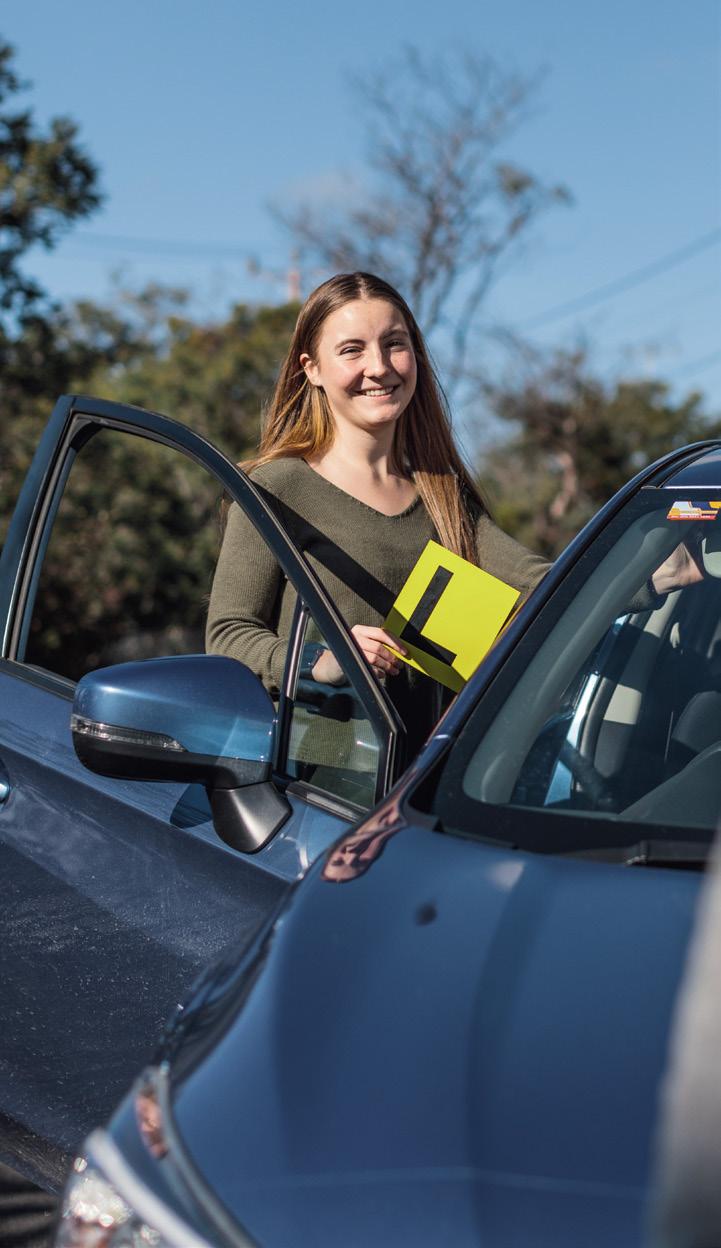
On average around 300 people are seriously injured or killed on Tasmania’s roads each year, including 67 young people. This is a tragic number that’s not improving. Now is the time to invest in protecting our young people.
With Tasmania well and truly in the midst of an election campaign, we’re driving home the message that road safety is an investment in our youth. Our program, which would see comprehensive road safety education embedded in secondary schools is designed to arm young Tasmanians with the knowledge and skills to navigate the roads with caution and care. It’s an approach that promises to significantly reduce road deaths and injuries, much like learn-to-swim programs have improved water safety.
Generational change begins with education. That’s why RACT, is seeking the development and implementation of a thoroughly structured, professionally-led road safety curriculum, encompassing both theory and practical learning.
The initiative is about ushering in generational change by laying the groundwork for responsible road use for years to come. The program will support young Tasmanians through all stages of licensing, provide invaluable assistance to parents and carers, and support disadvantaged youth to obtain their licence.
We need to take a different approach over the coming five years, with 40,000 Tasmanians expected to gain their licence. The cost of doing nothing will see more deaths and tragedy on our roads. The economic and social cost to the state alone is estimated to be $38M, let alone the countless families and communities devastated by lives lost.
As we count down to the election, we urge political leaders to support this lifesaving policy. Together, we can pave the way towards a future where every journey is safe, and every driver is equipped with the principles of road safety.
RACT stands committed to this vision. To find out more about how we can make our roads safer, head to our website.



Now in its third year, Trail Graze is back for its annual spotlighting of the incredible food and beverage producers in the state’s North West. Held 19-21 April, this weekend-long, family-friendly event sits smack bang in the middle of the school holidays too. Expect face painters , treasure hunts and nature games for the kids while adults can set about discovering local growers, makers and producers from the Tasting Trail.
For more, visit trailgraze.com






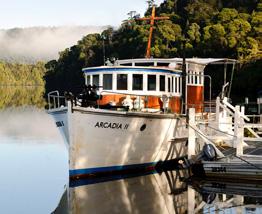




12-20 APRIL JAGUAR
While stage one commences in Hobart from the Wrest Point casino complex in Sandy Bay, stage two moves west to the Strahan Village complex on the shores of Macquarie Harbour. jagtas.org.au/nr24/

15-19 MAY
Showcasing Launceston as a cultural hub is this five-day immersive event that encourages participation in the arts at some of the city’s most beautiful venues. amtf.org.au
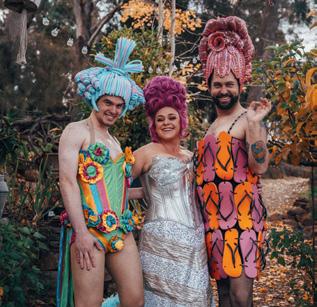
All event details are up to date at time of print, but can change. For updates, consult organisers directly.

22-24 MARCH
The East Coast Harvest Odyssey (aka ECHO) is back for another year. This year’s theme is based on one of our most cherished Tasmanian foods – oysters!
echofestival.com.au

15-16 MARCH
For a weekend filled with soulstirring rhythms, head to this blues extravaganza, dubbed Tasmania’s premier blues and roots event. Get ready for 20 hours of original blues and roots music. forthvalleybluesfest.com
1-30 APRIL
This month-long festival celebrates the Derwent Valley and Central Highlands. See vibrant foliage, fungi and fruits; enjoy local produce, wine and art; and explore the history, culture and natural wonders of the region. derwentvalleytasmania.com.au

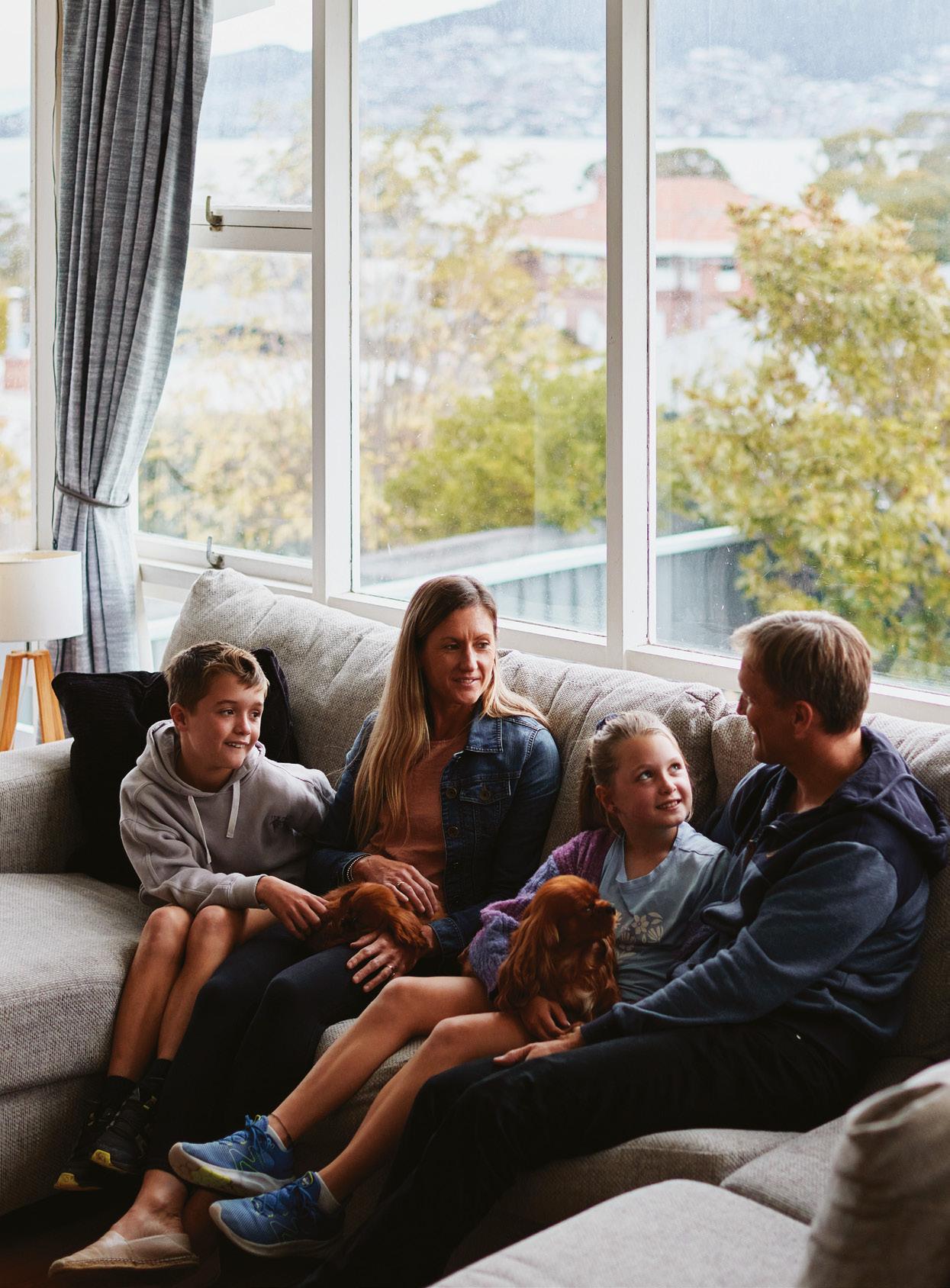
TOP five
Whether you’re looking for a quick pit stop on a long road trip or an afternoon of frivolity, these pubs will keep you warm and watered well into winter, Nola James writes.



1 DU CANE BREWERY, Launceston
This bustling Launceston taproom has its beer and pizza offering sorted. Brews are made onsite (tours are available, too) and there’s space for hundreds across three rooms and two bars. In winter, the best seats in the house are around the three-sided, glasswalled fireplace.
2 THE GREAT LAKE HOTEL, Miena
The Great Lake Hotel is just south of Liawenee, one of the coldest places in Australia, which means the pub’s three fireplaces are not just for decoration. Warm up with a beer in the sports bar, settle in for lunch in the restaurant, or dine alfresco by the firepit.
3 THE CLARENDON ARMS, Evandale
This charming, heritage-style pub is known for its leafy beer garden, particularly on Sundays when there’s live music in the afternoon. In less agreeable weather, snuggle up by the cosy indoor fireplace in the main dining room, which has an old English vibe.
4 CRADLE MOUNTAIN LODGE, Cradle Mountain
While Cradle Mountain Lodge is a top spot for luxury winter stays (snow! wombats! spa treatments!), its excellent Tavern Bar is open to all. Bistro-style meals are served seven days amid rustic surrounds; think raw timber, local stone and roaring fires.
5 THE HOPE AND ANCHOR, Hobart
By some accounts, this c. 1807 hotel is Australia’s oldest licensed venue. In 2023 it was sold to investor John Kelly (who restored the State Cinema), and he plans to bring the pub back to its former glory. Choose from the relaxed front bar, the ye olde dining room or memorabilia-clad space upstairs – there’s a cranking open fire in every room.

reminder
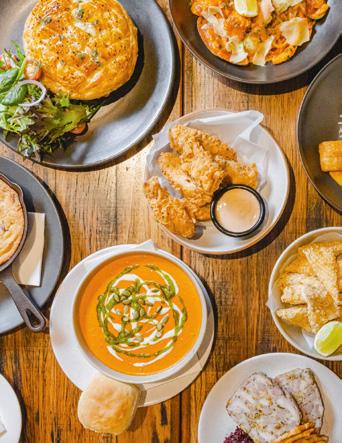
As always, please drive safely and responsibly; don’t drink and drive.

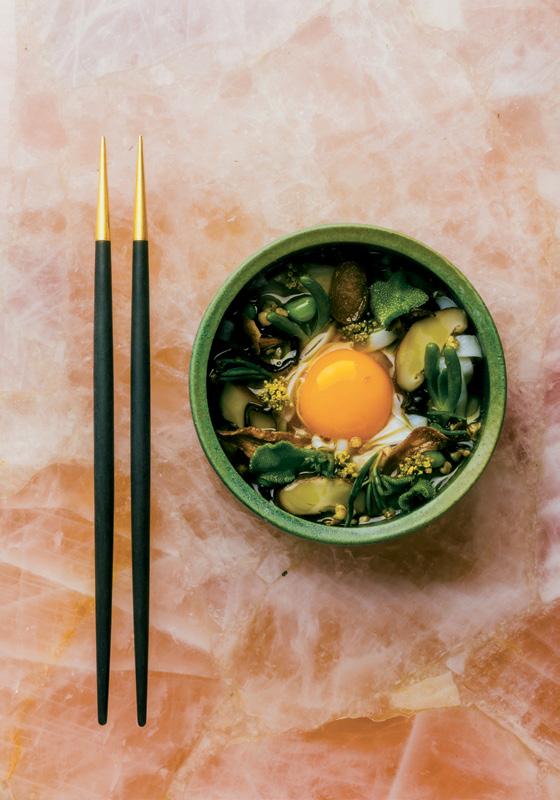
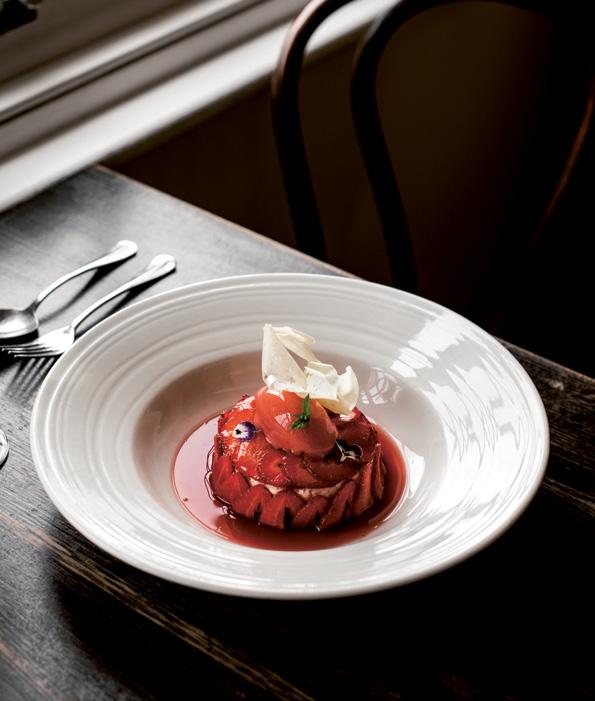
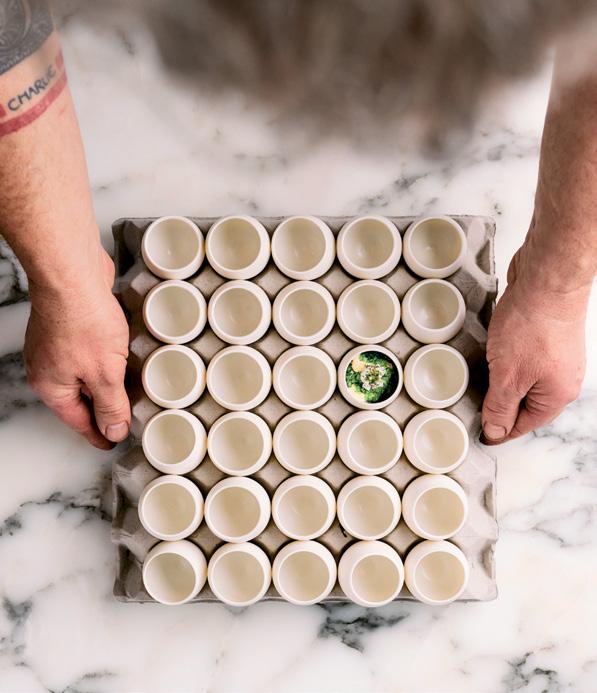


Nola James meets three local innovators leading the way in sustainability, from farm to fork.


It’s not hard to throw veggie scraps in the compost. When it comes to being an industry leader in sustainable food production in Tasmania, the cost of admission is high. Whether influencing laws around ethical sourcing or supporting sustainable staffing, these operators go above and beyond what they deliver on the plate.
More than 200,000 meals a year are served at Dubsy’s, Mona’s fast casual eatery, yet not a bio-plate or paper napkin is used. It’s all part of the museum’s ‘zero waste’ program, which sees single-use items banned across the business, from the coffee stand to fine-dining restaurant Faro.
It’s a strategy that feels more aligned with an organic cafe than one of Tasmania’s busiest cultural icons, and it’s just part of the business’ commitment to sustainability. “For us, it’s about scale,” says Vince Trim, Mona’s Executive Chef. “We’re really only at the beginning of what we can do.”
The all-in approach is largely driven by Kirsha Kaechele, wife of Mona founder David Walsh, artist and activist. She’s responsible for Tasmania’s 24 Carrot Gardens project, which teaches children from low-



income schools around Tasmania to grow, harvest and cook healthy produce, and CA$H 4 GUN$ – a conceptual artwork in the form of a gun buyback scheme in New Orleans.
These moves are far from performative, with changes afoot that the public wouldn’t normally see. Kitchens are being transitioned from gas (a fossil fuel) to induction, for example, and the restaurant linens are air-dried.
Kirsha and Vince’s biggest triumph is ‘eat the problem’, a company-wide ban on farmed meat that has resulted in a 34 percent yearly reduction in hospitality-related carbon emissions and may well change laws.
“We’ve always had venison on the menu,” Vince says, but it was shipped in from the mainland due to Tasmania’s ban on commercial deer hunting. (As well as being a lean source of protein, hunting wild venison keeps populations in check and reduces the need for intensive farming.)
Mona’s zero-waste program extends to its fine-dining restaurant, Faro; art, eating and sustainability come together; Executive Chef Vince Trim; Kirsha
They teamed up with John Kelly of Lenah Game Meats (who supplies wild wallaby and rabbits to Mona kitchens) for a lengthy lobbying campaign that involved consultation with government ministers, recreational hunters and diners.
Persistence paid off. In April 2023, the Tasmanian Government approved a two-year-long feasibility




“We’re really only at the beginning of what we can do.”
trial to use wild-shot deer for commercial purposes. For now, at least, the venison on Vince’s menus is as Tasmanian as the pea puree, white miso and celeriac cream it’s served with.
The natural growing environment for wasabi (the plant, not the fluoro-green paste sold in tubes) is high in the mountains of Japan, growing between rocks on the edges of rivers and streams fed by snow water.
That’s far from the farmlands of Port Sorell, where 4000 wasabi plants shelter in an unassuming greenhouse off the main highway. But at Shima Wasabi, Australia’s largest commercial wasabi farm, a hydroponic river system fed by recycled rainwater recreates the ideal conditions for growing the most expensive member of the brassicaceae
family (30g will set you back around $15, which works out to around $500 a kilo).
“You’ve got to be a purist to use fresh wasabi,” says Esmé Merilees, Operations Manager at Shima. She’s the first point of contact for the chefs who fly in from across the country to see how wasabi is grown in northern Tasmania.
“In Japan, fresh wasabi production has declined because the younger generations don’t want to work on farms,” Esmé says. Plus, Australian chefs want the real deal. “There’s plenty of imitators out there.”
In addition to selling wasabi paste and powders for general consumption, custom orders are key, with the likes of Tetsuya Wakuda (Tetsuya’s) and Andrew McConnell (Supernormal) showcasing picked-to-order wasabi leaves and stems on their award-winning menus.
You’d think that such a water-loving, fragile plant would be a drain on environmental resources, but here it’s just the opposite. “Wasabi hates summer,” Esmé says, so the cool Tasmanian coast – Tasmania has an antipodal latitude to Japan – provides the perfect home away from home. All the water needed for half-hourly feedings comes straight from the sky, while misters maintain alpine conditions year round.


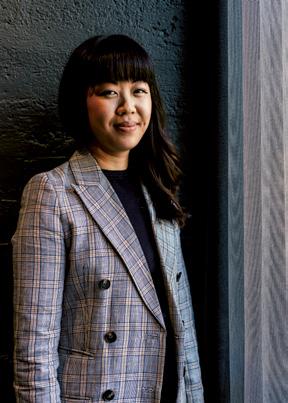

“I have a hope for the world ... that we can have mental health first-aiders in every workplace.”
Bianca Welsh started her psychology degree in 2011, less than a year after she and husband James Welsh bought iconic Launceston restaurant Stillwater. “We had an employee living with an eating disorder, and I needed to do something to help them,” Bianca says, adding that a conversation ultimately propelled that employee to seek professional help. “In the industry usually, they’d just be written off the roster. Instead, that person stayed with us for another year, and went on to become a medical doctor.”
Bianca graduated from the psych program at UTAS in 2018, and today uses lived and learned experience to create safer, more inclusive workplaces through mental health first-aid courses for restaurant and tourism workers (in partnership with the Tasmanian Hospitality Association and the Department of State Growth) and business-specific ‘mentally healthy workplace’ sessions.
“In Australia, 75 percent of people will experience some kind of mental illness by the age of 25. And in Tasmania, almost 80 percent of the hospitality workforce is aged between 16 and 25,” Bianca says. “If we guide our young people towards better health behaviours now, then potentially and hopefully, they won’t need to be on the reactive end of the mental health system. We can catch it early.”
The restaurant industry is notoriously a hotbed of bad behaviour, with long hours, shift work and a culture of heavy drinking taking its toll. “We can understand that if we can give an ear, give people a moment to be seen, that can make a huge impact,” Bianca says.
“I have a hope for the world, at least for Australia, that we can have mental health first-aiders in every workplace.”
Tasmanian restaurants are leading the way.



Get ready to embark on an electrifying journey at our brand-new Solar and Battery Showroom located at 62 Hopkins St, Moonah, TAS 7009! Step into a world of innovation and sustainability as we unveil the latest advancements in solar energy and battery storage solutions. Explore cutting-edge solar panels, revolutionary battery storage systems, and smart energy management solutions that will transform the way you power your home or business.
• WIN the ultimate energy solution: a state-of-the-art Tesla Powerwall!
• Say goodbye to energy worries with this cutting-edge battery storage system.
• Enter for a chance to revolutionize your home’s energy efficiency and sustainability.
• Don’t miss your shot at winning the future of energy – participate now and power up with Tesla!
To enter visit Tesla Powerwall Giveaway | I Want Energy Tasmania https://www.iwantenergy.com.au/tesla-powerwall-giveaway
* T&C’s apply, check our website for more information




24 / AUTO NEWS
27 / 0–100 REVIEW: KIA EV9 GT-LINE
29 / IN REVERSE: CITROEN DS 19
30 / ROAD TEST: HYUNDAI IONIQ 6
36 / THE CAR OF THE FUTURE

The distinctive aroma of a natural-leather vehicle interior may soon be a thing of the past as car makers look to clean up their environmental and ethical credentials. Korean car maker Kia is one brand experimenting with new synthetic leathers, along with other eco-friendly materials to replace petrochemical-based plastics. The company’s EV3 and EV4 concept cars feature what it describes as game-changing ecofriendly materials and methodologies. From sustainable fibre weaves that deliver a lightweight, slimmer seat design, to a console table made of mycelium (extracted from mushroom roots), the EV3 explores new materials and manufacturing techniques, including so-called biofabrication. The Concept EV4, meanwhile, features an interior that utilises natural dyes extracted from madder roots and walnut shells, 100 percent recycled cotton, and a console made of sustainable hemp fibres. Other sustainable materials already being introduced into Kia’s production include bioplastic, produced from sources such as vegetable oils, corn extract, sawdust and sugarcane; bio-based polyurethane which incorporates plant-based components and is used as a leather replacement; carpets created from 100 percent recycled PET, including recycled fishing nets; and bio paint created using rapeseed oil.
For more visit kia.com.au
In 1993, RACT became one of the 10 founding members of Australia’s New Car Assessment Program (ANCAP). The pioneering safety organisation marked the 30th anniversary of the first ANCAP tests by staging a live crash test of a 1993 Mitsubishi Magna, highlighting the yawning divide between cars then and now. With no airbags, basic lap-sash seatbelts front and rear, and a lap-only seatbelt for the centre rear seat, injury measurements showed the Magna driver would face a high risk of serious or fatal skull fracture and brain injury, while rear passengers would also have sustained serious injuries. ANCAP Chief Executive Officer Carla Hoorweg says Australians are far better informed and empowered to make safer vehicle choices today. “We’ve seen vehicle safety advance in leaps and bounds over the past 30 years as a result of ANCAP’s persistence and ability to influence consumerdriven change.”
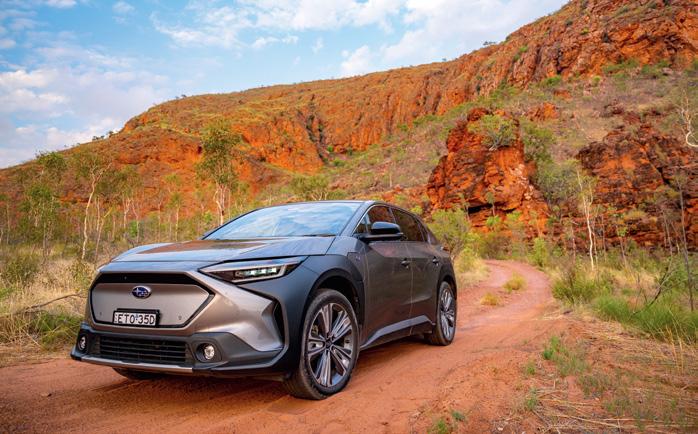

Subaru has rung in the new year with the first customer deliveries of its all-new Solterra EV, the name of which combines the Latin words for ‘sun’ and ‘earth’. Subaru’s first battery electric model shares its underpinnings with Toyota’s forthcoming bZ4X, but gets bespoke aero-inspired design, plus unique features and pricing. Available in two grades starting at $77,990 (MLP) for the Solterra AWD and rising to $83,690 for the Solterra AWD Touring, the electric SUV will be the most expensive model in Subaru’s line-up. It will also be one of the roomiest thanks to a generous 2850mm wheelbase and dedicated architecture that packages the 71.4kWh lithium-ion battery beneath the floor. The dual-motor drivetrain maintains Subaru’s commitment to all-wheel drive traction, with brisk performance promised via 160kW/337Nm outputs and a claimed range of 414km (WLTP). Standard features of both models include a 12.3-inch high-definition central touchscreen, 7.0-inch digital instrument pod, heated and powered front seats, a heated steering wheel, a powered tailgate, LED headlights and fog lights, and a digital rear-view mirror. The Solterra AWD Touring adds 20-inch alloy wheels over the base model’s 18s, a 10-speaker Harman Kardon audio system, a wireless Qi charger and synthetic-leather seat trim among other kit. For more visit subaru.com.au


Toyota’s rugged LandCruiser 70 Series has been the go-to vehicle for anyone needing serious offroad, towing and heavy-duty capabilities since its launch in 1985. Now, a new four-cylinder turbodiesel engine and a six-speed automatic transmission add a new chapter to the hard-working Cruiser’s Australian story.

340,000
The approximate number of 70 Series vehicles sold in Australia since it replaced the 40 Series in the ’80s.
12,000
Average combined sales of the 70 Series range over the past six years, including five of its bestever years for deliveries.
4100
The difference in dollars between the new 2.8-litre four-cylinder automatic models and their 4.5-litre V8 manual equivalents. Prices for the four-cylinder start at $75,600 (MLP) for the Workmate 76 Series Wagon and rise through nine variants to $83,500 for the 79 Series Double Cab Chassis GXL.
500
Torque in newton metres of the 1GDT 2.8-litre four-cylinder engine, versus the established 4.5-litre turbodiesel V8 manual (430Nm).
130
Approximate number of countries the 70 Series is sold in, with Australia (the largest market), accounting for one in five sales.
30
Percentage of 70 Series sales
Toyota Australia expects the new four-cylinder models to comprise initially, although dealers think it may be as high as 50 percent.
The year in which Toyota Australia is expecting to catch up on its backlog of 70 Series V8 orders, with the V8 order book remaining closed since late July 2022.

Percentage reduction in fuel consumption of the four-cylinder auto (9.6L/100km) versus the V8 manual (10.7L/100km).
6.7
Size in inches of the upgraded multimedia touchscreen, with wired Apple CarPlay and Android Auto fitted to all 70 Series grades.

Australia’s Real-World Testing Program gives car buyers relevant information that can help them choose vehicles with lower running costs and lower tailpipe emissions.
The Real-World Testing Program delivered its first results in late 2023, with the next tranche of results expected this quarter.
The program measures vehicles’ carbon dioxide and pollutant emissions and uses this data to calculate fuel consumption on Australian roads –results that can vary significantly from car makers’ lab tests that are required under Australian regulations.
In 2023, the program finalised results for nine small and mid-sized SUVs (seven petrol, one diesel and one hybrid) that were test-driven on a 93-kilometre route in and around Geelong, Victoria, that
includes urban and rural roads, as well as a stretch of motorway.
But in the first tranche of Real-World Testing, five vehicles had real-world fuel consumption 8 percent to 13 percent higher than their lab test results. Four vehicles’ real-world fuel consumption results were within 2 per cent of their lab test results.
Four out of nine vehicles tested recorded noxious emissions results that exceeded either the applicable lab test limits for Australian-regulated or European-regulated pollutants – or both.
The first tranche covers nine specific SUVs, seven of which were petrol vehicles. Much more work remains
to be done in testing a wider range of vehicle types, including more diesel and hybrid vehicles, utes and cars of all sizes. Real-World Testing has only just begun. The program is currently testing more SUVs. In 2024 it will also test small and medium passenger cars, people movers and utes, including petrol, diesel and hybrid models. Future testing of electric vehicles is on the radar, with work to be done on developing appropriate test procedures and metrics.
Over four years, the program will test about 200 vehicles.
The program is backed by the RACT and other motoring clubs and is managed by the Australian Automobile Association on behalf of the Commonwealth Government, which has provided $14 million in funding.


Kia keeps up the pressure on stablemate Hyundai by being first to market with an electrifying new seven-seat family SUV.
Story Harry WellerKIA HAS DRIVEN STRAIGHT into the space vacated by the Tesla Model X, lobbing its plus-sized seven-seat EV9 into a family SUV fray that has few contenders, and even fewer that can match its compelling combination of space, pace and value.
Readers who still think of the Korean car maker as a purveyor of cheap and cheerful buzz boxes will likely do a double take at the entry-level EV9’s circa $100k price tag, then fall right off their bar stool at the top-of-the range GT-Line’s $121,800 sticker.
But step inside the roomy and high-tech cabin and any lingering notions about the ‘old Kia’ are immediately blown away by the richly appointed interior trims, generous accommodation and premium finishes.
A panoramic widescreen digital display stretches across the EV9’s dash, with twin 12.3-inch screens: one for the main instrument cluster, the other for the infotainment system. With slick graphics, fast processing speed and a user-friendly interface, the system includes Over-the-Air (OTA) software update capability, just like EV rival Tesla.
Other high-tech features of the EV9 GT-Line include fingerprint recognition for start and driver profile selection, digital side mirrors, a digital centre mirror, wireless Qi phone charging pad, augmented reality head-up
display, remote parking assistance, 14-speaker Meridian sound system, and the latest version of Kia’s advanced driver assistance system.
The digital side mirrors use cameras plus dual 7.0-inch monitors mounted inside the doors to add additional wow factor to an interior already brimming with it. This includes sporty electric front seats clad in synthetic leather with heating, cooling and massage modes, plus a powered leg rest and full-flat recline mode.
Passengers in the second and third rows are well catered for too, thanks to the EV9’s generous wheelbase, low beltline and the absence of a transmission-tunnel due to its dedicated EV underpinnings. Additional amenities include window sun blinds, heated and cooled outer row seats, overhead vents, temperature controls and handy USB-C ports.
The line-up starts with the rear-wheel drive single-motor Air, costing $97,000 (MLP) with outputs of 160kW/350Nm and a range of 443km (WLTP) from its 76.1kWh battery. Next up is the AWD Earth, priced at $106,500 but equipped with a larger 99.8kWh battery for a range of 512km (WLTP), and dual motors delivering a muscular 283kW/700Nm.
The top-grade GT-Line gets the same battery, dual-motor AWD system and outputs as the Earth, but more kit for its $121,800 sticker. This includes bigger 21-inch wheels, which reduces its claimed range to 505km (WLTP), but the GT-Line makes up for this minor disadvantage with its unique electric motor boost function, which shaves seven-tenths off the Earth’s 0-100km/h sprint, stopping the clocks in a searing 5.3 seconds.
As quick as it is, the GT-Line’s LandCruiser-like 2636kg kerb weight means it can’t be hustled


through corners like a hot hatch, but its all-wheel-drive grip, disciplined suspension and instant acceleration still make for an impressively rapid, quiet and comfortable point-topoint family tourer.
THE SPECS
MAKE/MODEL: Kia EV9 GT-Line
BODY STYLE: Five-door large SUV
RETAIL PRICE: $121,000 (MRLP)
SEATING: 7
ENERGY CONSUMPTION: 22.8kWh/100km
ANCAP SAFETY RATING: 5 Stars (tested 2023)
MOTOR: Dual electric (282.6kW/700Nm combined)
BATTERY: 99.8kWh
RANGE: 505km (WLTP)
TRANSMISSION: Single speed reduction gear
DRIVE TYPE: All-wheel drive
0-100KM/H: 5.3 seconds
FOR MORE VISIT: kia.com.au


MODEL
Citroen DS 19 ENGINE
1.9-litre pushrod fourcylinder, front mid-mounted (56kW/137Nm)
CLAIM TO FAME
It would be another 25 years before mainstream passenger sedans matched this slippery Citroen’s aero-inspired drag coefficient.
A stunning symbol of French ingenuity, the Flaminio Bertoni-designed and supremely aerodynamic Citroen DS introduced multiple world firsts, most notably its innovative hydro-pneumatic suspension.
Story Harry WellerVisitors to the 1955 Paris Motor Show must have thought they’d been transported into the future when the covers were whipped off Citroen’s radical, teardrop-shaped DS 19 executive sedan in October of that year.
The French car maker had spent the better part of two decades developing the DS 19 and did not disappoint with its other-worldly styling and a dizzying array of technical innovations beneath its beetle-like carapace.
This included fully independent hydro-pneumatic suspension, which delivered superb ride comfort and roadholding unmatched by other cars of the era. The innovative system provided a self-levelling ride, along with driver selectable ride height, allowing the DS to hoist itself in the air for a flat tyre to be changed, or even drive on three wheels.
Changing a flat rear tyre required the fully faired quarter panel to be removed via a single bolt, which was also all that was required to remove the car’s other non-stressed and lightweight body panels.

Innovative centre-lock wheels were another unusual attribute of the original DS, allowing the wheels to be changed very quickly; handy for owners but also advantageous during a storied motorsport career that included two Monte Carlo Rally victories.
The car’s steel monocoque structure incorporated an early example of a crash crumple zone, while the mixed use of materials such as aluminium for the bonnet and fibreglass for the roof were daring innovations. So too the inboard front disc brakes and fully hydraulic braking system, both of which have entered the history books as production car firsts.
A three-speed manual gearbox mounted ahead of the longitudinal fourcylinder engine was another innovation, requiring no clutch due to its semiautomatic hydraulic-shift mechanism, but the ageing engine was a weak link in an otherwise revolutionary package.
The engine and many other aspects of the original DS would be upgraded during a 20-year production run that saw almost 1.5 million vehicles manufactured in sedan, station wagon and two-door décapotable (convertible) body styles.
The long and wide body design contributed to generous interior space, with the eccentric exterior theme continuing inside with features including a single spoke steering wheel and a rubber-button brake pedal.
Between 1961 and 1966 an estimated 1250 of the lower-grade Citroen ID 19 DS were assembled at Continental and General’s Heidelberg, Victoria, assembly plant, with these unique Australian versions known as the Parisienne to distinguish them from the imported DS.
The Citroen DS 19 regularly features in lists of the world’s most influential vehicles. It is also regarded by some pundits as one of the most beautiful automotive designs of all time, which is fitting given that its name is a play on the French word déesse, meaning ‘goddess’.

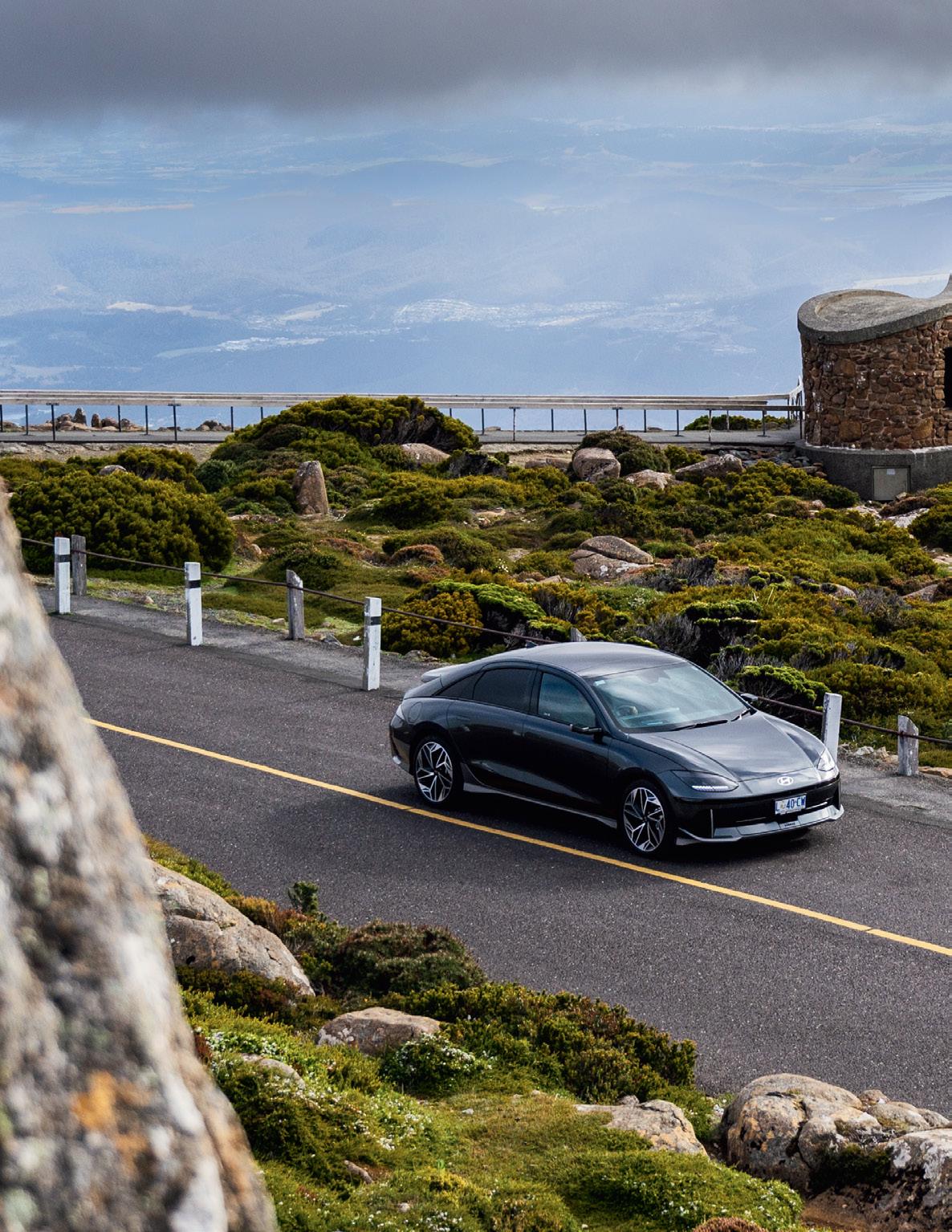

It feels like the future has arrived when behind the wheel of the all-electric IONIQ 6. Andrew Bain takes Hyundai’s latest EV for a spin around Hobart.
Words Andrew Bain Photos Stu GibsonFrom Battery Point, I weave a street-art trail through the city ... ascending mural by mural from the waterfront.

At an electric vehicle charging station on Hobart’s docks, I’ve drawn a small crowd.
Passers-by pause, as do the owners of another EV on charge, curious about the Hyundai IONIQ 6 I’ve just reversed into the space.
The car’s slick, streamlined shape is drawing admiration, though the most quizzical glances settle on the side mirrors, which aren’t mirrors at all. Instead, two cameras hang from the side of the sedan, projecting rear-view images onto wings that protrude from the dashboard. As I set out driving from the docks, these projected road scenes feel a little like having a pair of tiny Jeffrey Smart paintings hanging on my dash.
It’s my first drive of an EV and it seems a wellchosen introduction, with the IONIQ 6 named as the World Car of the Year in 2023, an award judged by more than 100 motoring journalists
from 35 countries. In the same awards, it also picked up Design of the Year in a nod to the very aesthetics that are proving so eye-catching at the charging station.
From the docks, my day in the IONIQ 6 will take me through Hobart and ultimately to the top of Kunanyi/Mt Wellington, a meandering sea-to-summit spin through the city and onto the open mountain slopes.
I turn south first, wriggling through the streets of Battery Point, where the IONIQ 6 is a technological counterpoint to the lines of historic Georgian cottages. The vehicle’s interior is a classically futuristic EV cocoon of leather upholstery, air-conditioning inside the front seats to cool your back, and a dashboard with twin 12.3-inch screens – one for infotainment and the other a digital instrument cluster.
Then there are those digital mirrors that headline the IONIQ 6’s gadgetry, though they only come in the top-of-the-range EPIQ model. The cheaper TECHNIQ and DYNAMIQ have

standard side mirrors, leaving the dashboard mirror extensions hanging wide and empty like a cormorant’s drying wings.
From Battery Point, I weave a street-art trail through North Hobart, the city and South Hobart, ascending mural by mural from the waterfront. Among the most compelling –and just the spot for my morning coffee and a gathering of sweet baked goods to fuel my wanderings on the mountain’s trails – is at South Hobart cafe Bear With Me, its side wall covered by a 10-metre-long platypus in celebration of the nearby Hobart Rivulet’s most famous resident.
One of the most noticeable features of the IONIQ 6 in this urban environment is that blind spots are a thing of the past. Each time I indicate, a blind-spot camera pops up like a spy-hole on the cluster screen, while a windscreen hologram also notes any vehicles hiding in my blind spot.
Through the morning traffic, the IONIQ 6 travels easily, but its happy place is when we tackle the more open road of the climb.




THE SPECS
PRICING • from $78,825 (EPIQ $95,666)
BODY STYLE • Sedan
SEATING • 5
BATTERY • 77.4kWh lithium-ion
ELECTRIC RANGE • 519km
CHARGING TIME • 18 minutes from 10-80% charged
MAX POWER • 293kW
MAX TORQUE • 605Nm
0-100KM/H • 5.1 seconds
SAFETY • 5-star ANCAP rating (tested 2022)
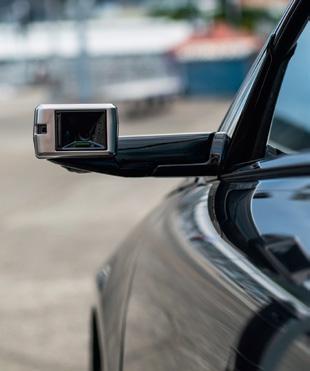




Past the almost Gothic sandstone facade of Cascades Brewery – a building that turns 200 this year – the drive becomes a fun spin on mountain roads, the car gliding around bends as though on rails and punching like a boxer when I slip the drive into sport mode.
As I rise up Pinnacle Road, cyclists whirr down from their morning climbs, and the car is as silent as the forest that encases it, at least when it’s not beeping and binging a host of warnings – nagging noises that would be the IONIQ 6’s greatest annoyance, along with a lack of headroom in the back seats.
Inside, it’s lit for fun, with a choice between 64 colours of lighting. I choose green in keeping with the bush-covered slopes of Kunanyi/ Mt Wellington. Pair it with the IONIQ 6’s Sounds of Nature setting, playing a soundtrack of anything from the murmur of a forest to a crackling fireplace, and you’ve got a selfcontained ecosystem.
Picking up a second coffee at the Lost Freight shipping-container cafe at The Springs, I continue winding up the slopes to Big Bend, where I park the car and set out on foot on the Lost World Track. Scrambling over boulders across the slopes of the secondary Mt Arthur, the track is a short portal into the Jenga-like puzzle of cliffs and fallen dolerite columns that is the Lost World, a scaled-down version of the Organ Pipes.
Finally, the summit beckons. Winds rake across the alpine tops of the mountain and cloud skims low overhead – a classic Kunanyi day – but the IONIQ 6 barely seems to feel the gusts, with the sleek, low design providing an aerodynamic profile that’s inspired by the curve of an aeroplane wing and the shape of a diving peregrine falcon.

Priced from $67,142
• Driving range; tinted glass roof
• No spare wheel; no Apple CarPlay or Android Auto


High above the city, I reach my goal and wander out onto Kunanyi/Mt Wellington’s summit boardwalks, from where Hobart looks painted into the landscape below. The climb has been fun in this smooth and sassy vehicle, but I suspect the drive back down will be even better.
Scan the QR code or visit ract.com.au/ membership/journeys to see this Road Test brought to life on video.

Priced from $73,312
• Driving range; in-car internet connection
• Road noise; interior space

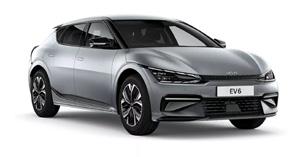
Priced from $78,185
• Spacious inside; high performance
• Lacklustre interior; no spare wheel
For almost 140 years the automobile has been a unique fusion of the here and now, and a pointer of things to come, with car makers constantly pushing boundaries in areas including safety, performance, technology and styling.
So, what will the car of the future look like? Harry Weller investigates.


Modern cars are already more connected than ever before with features including Bluetooth, smartphone mirroring, in-car modems, live navigation, over-the-air (OTA) updates and the ability to alert emergency services in the event of an accident.
Expect the connectivity trend to accelerate in the years ahead as the car of the future becomes the equivalent of a supercomputer on wheels, capable of thinking and acting for itself to avoid accidents, traffic jams and more.
Experts believe there’ll be significantly more interaction between individual cars through greater use of the growing computing power and sensors in vehicles, which will help reduce accident rates.
Creating a transport network that utilises communication between vehicles, infrastructure and individual mobile devices to more effectively plan travel has enormous potential to improve traffic flow.

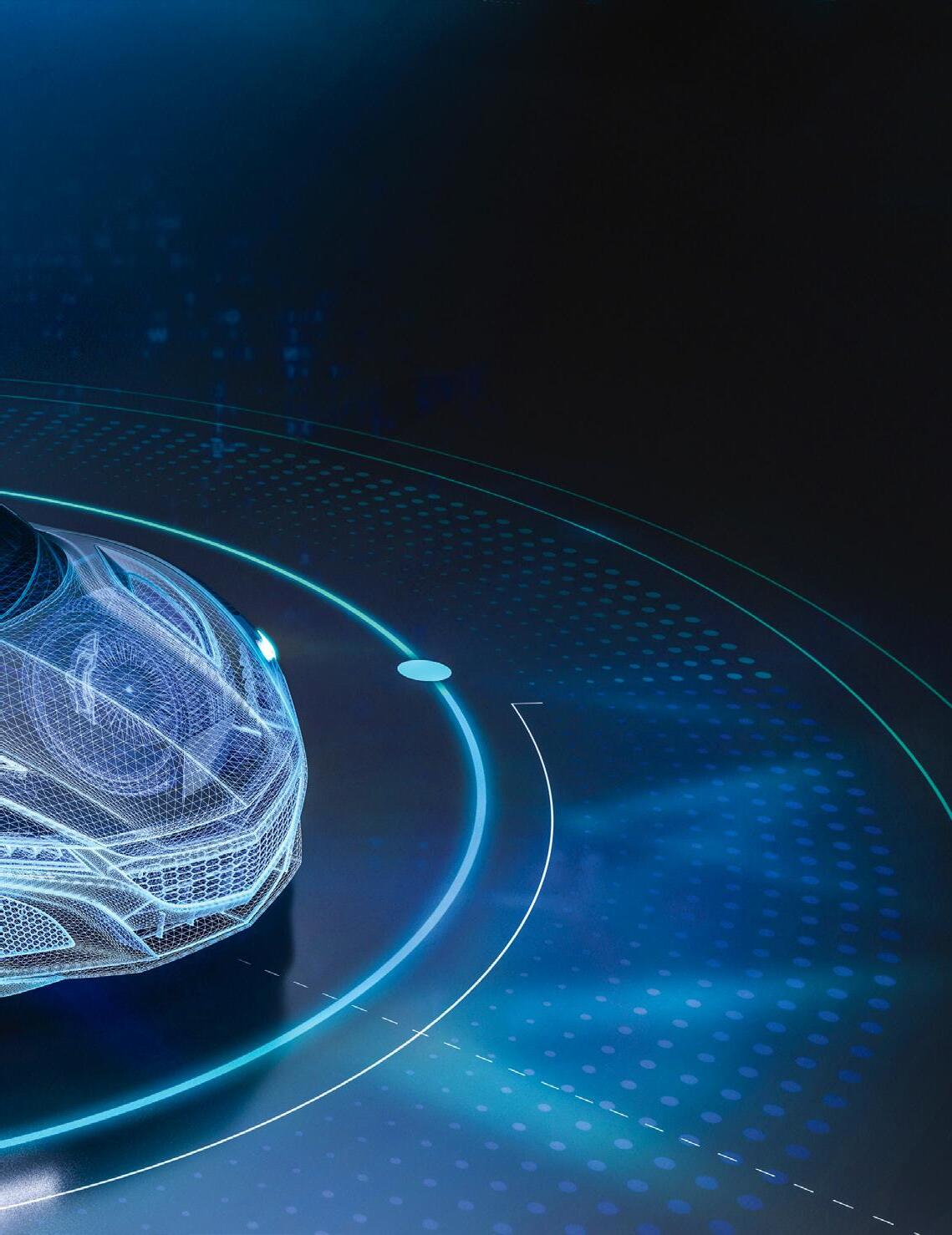
In this scenario pedestrians, bicycles, private cars and commercial and public transportation traffic are all woven into a single connected network. The arrival of vehicle-to-cloud and vehicle-toinfrastructure communication will enable your car to recommend alternative transport options when congestion is unavoidable.
The car of the future will be safer than ever before, with one of the most significant changes being the move towards autonomous driving.
While there are understandable concerns about the idea of cars that drive themselves, there are already millions of cars on our roads that operate with a degree of autonomy. If your latemodel vehicle has features like Autonomous Emergency Braking (AEB) or Adaptive Cruise Control (ACC), then you’re already driving a semiautonomous vehicle.
The Society of Automotive Engineers (SAE) categorises autonomous driving according to six levels, from Level 0 ‘no driving automation’, to the fully driverless Level 5 where the vehicle can perform all driving functions by itself in all circumstances.
With dozens of L4 self-driving vehicle trials underway throughout the world – meaning the vehicle can manage all traffic situations by itself, albeit under certain circumstances such as on selected roads and in fine weather – and manufacturers including Tesla, Mercedes-Benz and Hyundai pushing to be the first-to-market with a fully autonomous car, it’s only a matter of time before we see driverless cars on our roads.
“Obviously when it comes to safety, we cannot compromise anything, or take shortcuts, and we need to get the technology right. But it will be coming and when we talk about motoring in 25 years’ time, we will be driving autonomous vehicles in some form,” says Mercedes-Benz Australia’s Head of Sales Performance and Operations, Andre Dutkowski.
Hydrogen has long been touted as the ‘fuel of the future’ and the ultimate solution to the issue of vehicle tailpipe emissions. This is because hydrogen can be produced safely using nothing more than water and green electricity, and is virtually non-polluting.
In addition to its clean energy credentials, it’s
“When we talk about motoring in 25 years’ time, we will be driving autonomous vehicles in some form.”
the versatility of hydrogen to power everything from cars to trucks, buses and even ships, along with its ability to be transported as a liquid or a gas, and therefore exported, that has people so excited about its potential.
Hydrogen can either be burned in a modified internal combustion engine, or more commonly used to generate electricity in a hydrogen fuel cell electric vehicle (HFCEV), production versions of which are currently manufactured by the likes of Honda, Hyundai and Toyota.
Hyundai’s Senior Manager of Future Mobility and Government Relations, Scott Nargar, says one of the major challenges preventing wider HFCEV adoption is the cost and complexity of building the dedicated refuelling infrastructure they require.
But he also believes the combination of rising government and industry action on CO2, the declining cost of renewable energy which can be used to create green hydrogen cost-effectively, and falling costs of the vehicles and their fuelling stations, are coming together to create the ideal conditions for broader adoption of the technology.
“Australia, with its existing ports and quality infrastructure, plus our abundance of wind and solar power potential, is in a unique position to maximise the opportunity presented by hydrogen. There is no better place in the world to establish a green hydrogen industry,” he says.
While there seems little doubt the future of automobile propulsion will be electric, the transition to a fully electric vehicle fleet in some countries including Australia will take years, perhaps even decades.
During this time there will be a still-sizeable fleet of internal combustion engine (ICE) vehicles on our roads, with eFuels emerging as a promising option to ensure these vehicles can continue operating but with a much lower carbon footprint than today.
Electricity-based fuels, or eFuels, are carbonneutral fuels produced with renewable energy to
create green hydrogen through electrolysis, with the hydrogen then combined with carbon dioxide in a reactor to produce eFuel. The carbon-neutral fuel can be used as a direct replacement for fossil fuels in cars, trucks, ships and aeroplanes.
Porsche has invested heavily in the development of eFuels, partnering with Siemens Energy, ExxonMobil and others to establish a Chilean manufacturing plant that will produce “nearly CO2 neutral” eFuel for use in its race cars, and to keep older internal combustion-powered Porsches on the road.
Tasmania is also emerging as an eFuel player, with HIF Asia Pacific in the process of obtaining approvals for Australia’s first large-scale, carbonneutral eFuel production facility near Burnie.
“At full operations, the HIF Tasmania facility is expected to produce up to 100 million litres per year of carbon neutral eFuels, reducing global CO2 emissions by approximately 260,000 tons per year, the equivalent of decarbonising 52,000 cars on the road today,” says HIF Asia Pacific CEO Ignacio Hernandez.
With its year-round sunshine, Australia is ideally placed to exploit the clean, green solar energy that falls from our skies. Householders here have long since switched onto the benefits of this free form of energy, with Australia having the highest per capita adoption of household solar in the world.
Which begs the question, why aren’t we also powering our cars this way?
Richard Hopkins, Professor of Practice at UNSW and principal of the world-record-breaking Sunswift Racing team, believes it’s unlikely we’ll see cars that are purely powered by the sun in his lifetime, although the ability for solar to power cars on short journeys and to top up batteries is certainly viable.
Several electric car makers are already using solar roofs to help charge their batteries in this way, including the Mercedes-Benz Vision EQXX concept, the Fisker Ocean and the Hyundai IONIQ 5.
Professor Hopkins says the practical limitation of fully powering passenger cars with solar is the sheer number of photovoltaic cells currently required. Despite this, there have been concerted recent efforts to launch the world’s first publicly available solar-powered car, including by Dutch company Lightyear which went so far as starting production of its Lightyear 0 solar car at a plant in Finland in 2022, before promptly shutting down just a month later after the company got into financial difficulties.
As more EVs fill our roads, a growing number will offer bi-directional charging, also known as vehicle-to-grid (V2G), allowing people to unlock their vehicles not just as transport assets but also as energy assets.
Paul Sernia, one of the founders of Brisbanebased company Tritium, a global leader in the design and manufacture of DC fast chargers, sees the opportunity for electric cars to become part of our national power grid by feeding power back to the grid from their vehicle battery and vice versa.
• CADILLAC LYRIQ
Famed US luxury marque Cadillac will return to Australia in late 2024 with its all-new battery-electric Lyriq SUV.
• FORD RANGER PHEV
The Ford Ranger was Australia’s best-selling vehicle in 2023 and will add a Plug-in Hybrid Electric (PHEV) variant in early 2025.
• HYUNDAI IONIQ 7
Closely related to the Kia EV9, Hyundai’s IONIQ 7 will be the brand’s first family-sized all-electric seven-seat SUV.
• KIA TASMAN
Set to debut in 2025, the Tasman will be powered by a 2.2-litre turbodiesel, with a battery-electric version expected in 2026.
• TOYOTA FT-SE
The sleek electric sportscar concept was one of the breakout stars of the 2023 Japan mobility show, with some pundits predicting a 2027 launch date.
Several different EV and PHEV models available today already offer this technology, including the Kia EV9, Mitsubishi Outlander PHEV and the Nissan Leaf, with V2G expected to become more mainstream in the future.
“I think it’s exciting if we have millions of cars every day moving energy throughout our cities. I call it the internet of mobile energy. The roads become the electricity grid of the future,” says Paul.
To some extent this bidirectional capability also minimises the common concern about the electricity grid’s ability to cope with the growing number of EVs needing to be charged, since the fleet of EVs will be able to effectively push-and-pull energy into and from the grid as required.
“I don’t believe (the grid) will need to be upgraded or that we’ll need to build more power plants to power electric vehicles. What we’ll really see is that charging will happen as a managed process,” says Paul.
Inspired to know more about EVs? Scan the QR code or head online to ract.com. au/membership/journeys to read our beginner’s guide to buying an electric car.



42/ TRAVEL NEWS
45/ PIT STOP: QUEENSTOWN
48/ THE FUTURE OF TRAVEL
The Huon Valley’s newest accommodation offering does not do wifi, TVs nor children. Three adults-only luxury eco-cabins sit on 36 acres of rugged bushland, and all feature a wood-burning stove, private deck, deep stone tub with tree-top views and a kitchenette. Rates include breakfast daily and dinner on your first night, with cheese boards on request.
For more, visit hunterhuonvalley.co
Explore our state with Nola James

From Old Wharf to New Wharf, this interactive walking tour uses retro viewfinders to show you what Hobart was like 150 years ago. macq01.com.au/experiences

Cruise through southern Tasmania’s top distilleries and cellar doors. The signature tour covers the above; dedicated whisky, wine and gin tours are also an option. drinktasmania.com.au

Catch your own wild brown and rainbow trout with Trout Territory’s guided fly-fishing tours. Packages include equipment, transport from Hobart or Launceston, lunch and tuition (if you need it). Just BYO sunscreen. troutterritory.com.au

Sparkling wine specialist Bellebonne has joined Evenfell Wines in a new cellar door and restaurant in Legana, near Launceston. Chef Tom Kirby (ex-Quamby Estate/Hazelbrae) is sourcing produce from local farmers markets, fishing boats, oyster farms and country fields; head to the tasting room to try Natalie Fryar’s outstanding sparkling wines alongside Evenfell’s estate-grown chardonnay, pinot noir and cabernet sauvignon, made by award-winning winemaker Liam McElhinney. evenfall.au


Want to send a bit of Tassie to the mainland? Rebecca Sinclair of Criterion Street Cafe and Tori Keygan (ex-Bruny Island Cheese) have teamed up to launch Gathered, a hamper and gifting offering. The focus is on small-batch producers, with custom finds from the likes of Rough Rice, Punch & Ladle, Lavada skincare and Granville Pottery. “We like to celebrate the idea of a feast, but for all of the senses,” Rebecca says. The duo delivers nationwide. gatheredtas.com.au


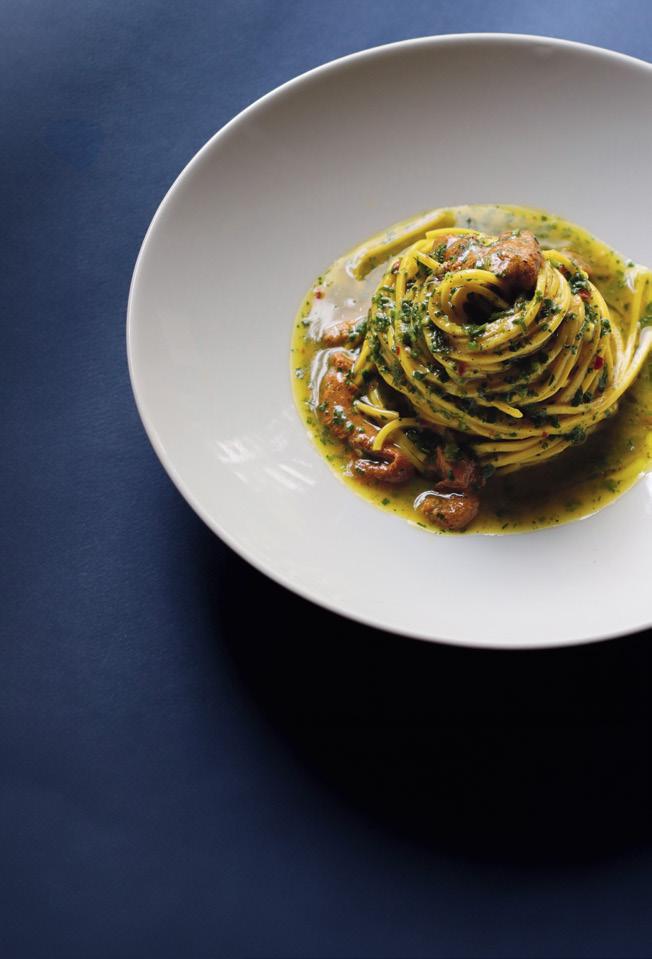
The team behind award-winning Hobart restaurant Fico has opened a ‘not just pasta’ bar at 4 Victoria Street. Pitzi, a partnership between Federica Andrisani, Oskar Rossi and Fico sous chef Dana Gleeson, channels retro vibes, with ochre tiling and terrazzo bar tops. It’s walk-in friendly, with about 30 seats inside and street-facing tables perfect for a Campari spritz in the sun. pitzipitzi.com.au
Hobart’s infamous The Waggon and Horses hotel has been given a new lease on life. Now just ‘The Waggon’, it reopened in December 2023 after an 18-month refurb. Alistair Derham, Paul Wensor and Klaa Clements are at the helm – you might recognise those names from the New Sydney Hotel. The downstairs area sports a more formal dining room and a lounge-style bar; upstairs are seven boutique hotel rooms, all with ensuites. Alistair promises pub style dining “but a bit fancier”, and natural wines, “but not exclusively”. thewaggon.au


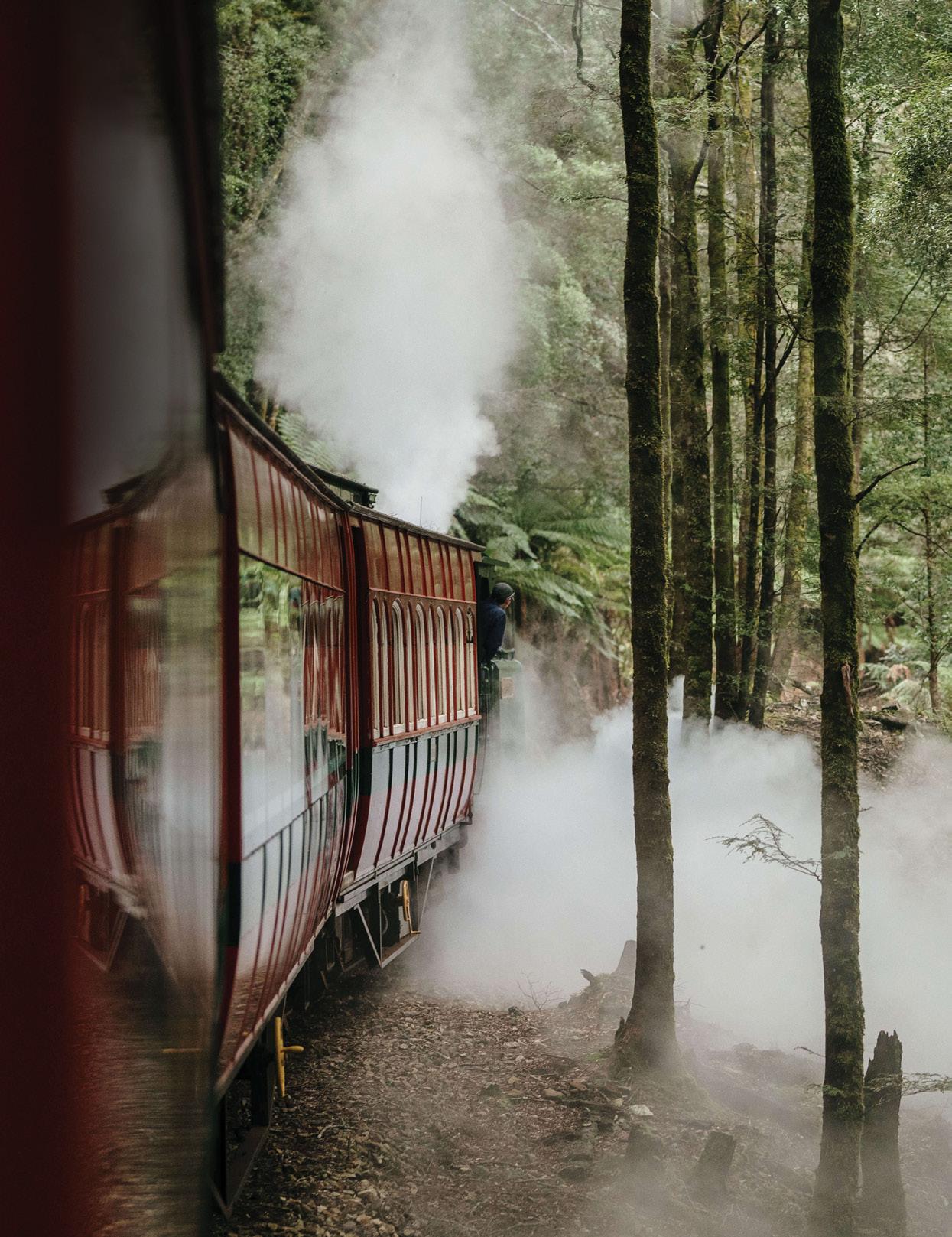

Once one of the world’s richest mining towns, Queenstown proudly wears its scars, from the bare mountain slopes that surround the town to the grazed knees of its footballers. But there’s much more within, writes Andrew Bain.
It’s like lunching in a haunted house when you take the short drive to Linda Cafe, set beside the blackened concrete shell of the short-lived Royal Hotel. Try warming homemade soups and excellent cakes and sweet treats in the Gothic setting.
Art is Queenstown’s new boom. Step into the 1901 Empire Hotel – the ‘grand old lady of the west coast’ – to find the Empire Art Box, bringing together timber and jewellery pieces, paintings and photography from west coast artists. Stick around to view the hotel’s own masterpiece – a blackwood staircase that was shipped from Britain during Queenstown’s headiest mining days.
SEE Queenstown’s lunar landscape has long been its own strange attraction. Soak it in on the descent into town along the stretch of the Lyell Highway known as the 99 Bends, stopping for a walk to Horsetail Falls on a boardwalk clipped to the slopes. Visit when the Queenstown Crows are playing a home match to see the notoriously bloody combination of Australian Rules football and a gravel playing surface.

It’s coffee by day and chardonnay by night at descriptively named Moonscape, Queenstown’s first wine bar (cum cafe). Tasmanian premium wines are the star ticket, but there are also four taps of craft brews, with a beer garden to match.
Discover how Queenstown’s other half lived with a night on high at Penghana, the elevated mansion built for the general manager of the Mount Lyell Mining and Railway Company in 1898. Its half-dozen rooms have retained their period style, right down to the silverservice breakfasts. The Owen Suite – the manager’s original bedroom –has arguably the best view in town.


• Linda Cafe
• Empire Art Box
• Horsetail Falls
• Moonscape
• Penghana
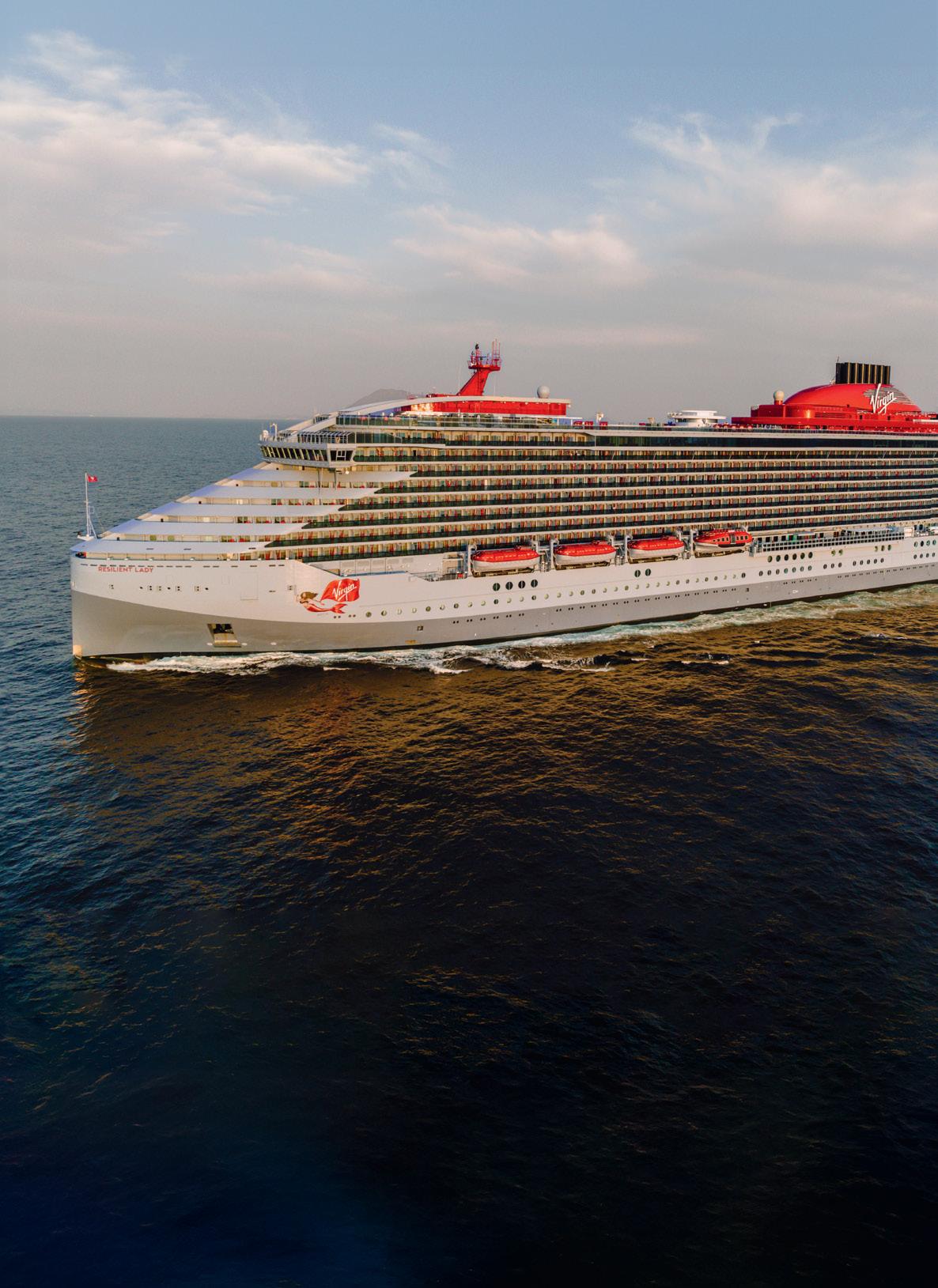
Resilient Lady, the latest gem in Virgin Voyages’ adults-only fleet, has finally graced the shores of Australia. Eager to uncover whether this adults-only cruise lives up to the hype, Emma Jackson hops on board for a two-day voyage from Sydney to Melbourne.


I’ve always thought cruising holidays weren’t my scene, but an invitation to experience Virgin Voyages’ fresh take on sea travel is just too tempting to ignore. With the promise of an adults-only ship with innovative dining options, I’m hooked.
The welcome by the vibrant hosts, decked out in flamboyant Virgin red, makes it clear from the jump that this cruise will be anything but ordinary. Resilient Lady feels like a boutique hotel with its luxurious lounges and modern art installations.
My sea terrace cabin is a haven of thoughtful design with its convertible sea bed, tablet-controlled amenities and a private balcony with a bespoke hammock. I could quite easily stay put in this comfortable cocoon, but leave my room I must.
The sail-away party on the pool deck is a vibrant spectacle that does not disappoint. Think guests dancing in the pool, dazzled by a sequin-clad drag queen, with the enthusiastic ‘Happenings’ team encouraging everyone to get involved. Notably, there’s a smartphone app allowing guests to ‘shake for champagne’ – though passengers do need to be mindful of the associated costs. They can add up.
Distinguishing itself with an inclusive approach, Virgin Voyages covers nearly everything on board except alcohol. From diverse eateries to gratuities, Wi-Fi, soft drinks and unlimited group
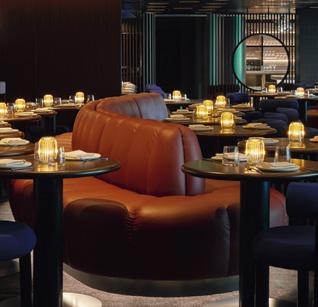
fitness classes, the cruise says it “aims to provide a seamless and enjoyable experience for passengers”. And it does.
Food options range from casual eateries at The Galley to experimental cuisine at Test Kitchen. The absence of crowded buffets and designated dining times, coupled with sustainably sourced and made-to-order food, mark a refreshing departure from typical cruise dining.
Then there’s the entertainment. With original productions, pop-up acts and immersive experiences, it feels like there’s something for everyone. From the lively dinner show Another Rose to the cheeky quiz Miss Behave, there’s a festival-like atmosphere on board. A highlight is the signature event Scarlet Night, which unfolds as a ship-wide soiree featuring live music, karaoke, games and pop-up performances.
Sustainability is also a standout feature, with Virgin Voyages boldly eliminating single-use plastics and committing to net-zero carbon emissions by 2050. Reef-safe sunscreen for sale underscores its commitment to environmental responsibility.
In a cruise industry dominated by family-oriented options, Virgin Voyages presents an inventive, alternative experience, boldly differentiating itself from more traditional choices. One of the highlights of my experience is the warm embrace of the LGBQTIA+ community, which creates an environment for everyone on board to express their true selves.
While Virgin Voyages’ offering may not be the first choice for travellers seeking tranquility over revelry, it’s carving a niche with its out-there entertainment and daring approach. All aboard!
Want to read an extended version of this article? Scan the QR code or visit ract.com.au/membership/journeys for the longer read and info on how to book through RACT Travel.




Tasmanian tourism operators are gearing up for a new type of traveller: the climate-conscious tourist. Amanda Ducker explores how local businesses are using digital tools to ride this eco-tourism wave.

Four years ago, Zoe Exton (pictured above), co-founder of South Hobart-based Tasmanian Mountain Bike Adventures, was having conversations with her customers around trails, biking tips and pick-up times. Fast forward to today, and a new kind of tourist has emerged – one with a deep commitment to the environment and sustainability.
“I’ve noticed since Covid, there’s a new focus,” Zoe says. “People are asking a lot more questions about responsible practices and what we do, and appreciating how we respect the environment, for example by avoiding damaged tracks and providing rubbish bags in their bike packs for collecting litter on the tracks. They want to align with companies that share an ethos.”
While mountain biking is an inherently lowemission activity, Zoe and her husband and cofounder Phil proactively manage their carbon footprint in a host of ways. They have replaced office lights with LEDs, switched to an ultra-low washing cycle for hi-vis vests and gloves, chosen Tasmanianmade hand sanitiser by organic brand My Shay and,
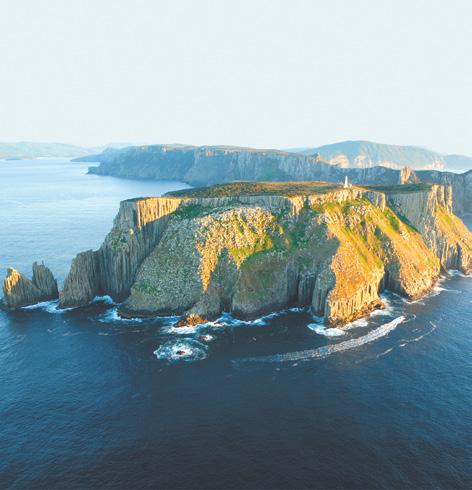
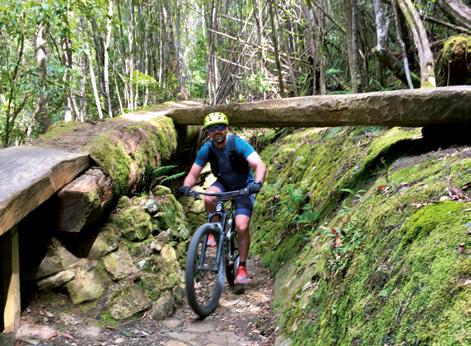
of course, relied heavily on pedal power not cars to get themselves around, encouraging their team to do the same by providing lockable bike storage and change/shower facilities for staff.
The couple has intensified efforts after joining an online emissions reduction community last October. Their business is among 51 local tourism operators using a digital tool from ERC Australia, an emissions reduction collective.
Not only are Zoe and Phil now tracking all their sustainability efforts, they’re feeling inspired to do even more, from purchasing an e-bike to collect
“People are asking a lot more questions about responsible practices and what we do, and appreciating how we respect the environment.”


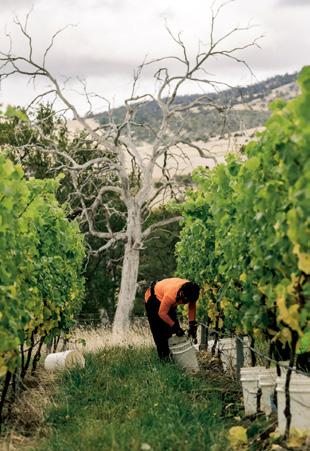

their shuttle bus from kunanyi/Mt Wellington trailheads to making their own cleaning products with vinegar and lemon.
Zoe says there’s an often-overlooked wildcard that significantly influenced her business’s carbon footprint.
“The supply chain is the area that is not totally in our control, but it’s the area where we can make the biggest difference,” she says, highlighting the importance of asking questions and sourcing locally. “For example, we are using merino beanies from a Tasmanian company Smitten, considering it a reliable local supplier that is very focused on carbon emission reduction itself.”
The MyERC program not only helps set goals but also fosters community spirit by allowing users to share data with customers and fellow Tourism Industry Council of Tasmania members in the program.

“It’s about creating alliances with businesses that think the same as you and then spreading that vibe across the industry. There’s a heap being done,” Zoe notes.
With wine grapes highly sensitive to the smallest temperature increases, Paul Smart, viticulture and winemaking officer at Wine Tasmania, likens vineyards to canaries in the coal mine for climate change. “Emissions reduction is therefore a key priority as part of the Tasmanian wine sector’s overall environmental sustainability,” he says.
Paul is the driving force behind Wine Tasmania’s VinØ Program (pronounced ‘vin zero’), launched in 2014 to help producers minimise negative environmental impacts. Almost half of the state’s vineyards now operate under VinØ, receiving annual benchmark reports on soil health, pest and disease management, biodiversity, water, waste, community, biosecurity, winery management and carbon emissions.
Stargazer Wine vineyard manager Bryn Williams (pictured above) is a big fan of the program. “It’s


been very valuable for Stargazer to assess its own procedures through the VinØ framework,” Bryn said, accepting the 2023 VinØ Program Champion Award on behalf of the Coal River Valley vineyard. “It goes to show how large an impact small incremental change can have on a business. For example, we have moved to a lighter-weight glass bottle for packaging, which reduces [freight-related] emissions. All our boxes and the tape on our boxes are recyclable now and our labels are made from recycled sugarcane stalks.”
Stargazer is adapting the vineyard in a multitude of small ways, too, including minimising disruptive digging. “We are avoiding cultivation, to boost the organic matter in the soil so it sequesters more carbon in the atmosphere.”
Bryn says nearly every suggestion Stargazer has taken up has been generated through the VinØ program tool. Water usage is one example. “You always know what you can improve on. When we saw we weren’t scoring as well as we wished on water, we invested in an automated irrigation program which is set to run at night, offering off-peak rates, reducing evapotranspiration and saving the fuel I’d use driving to and from Hobart to manually manage irrigation.”
Bryn welcomes the way the market is also
76% of global travellers say they want to travel more sustainably in the future.

inspiring changes on the ground. “Viticulturists are farmers at the end of the day and need a bit of a push to evolve their practices to meet contemporary standards,” he says. “I’ve noticed lately that your average wine drinkers really want to know where the wine comes from and how it’s grown. They want to know your story. It’s as important to them as the taste and the price point. The hugely growing interest in environmental aspects of growing wine is a side product of people generally being environmentally aware.”
Meanwhile, Tasmanian start-up Sumday is expanding the accounting rulebook by giving it a green spin. Co-founders Jessica Richmond, Lindsay Ellis and Danny Hoare say that no business’ books are complete without carbon accounting, a framework to measure and track how much greenhouse gas an organisation emits. The trio developed rigorous carbon accounting software, positioning it alongside traditional financial reporting. Originally an accounting firm, Sumday now partners with business management giant Xero, integrating carbon accounting into mainstream accounting services. The goal? To make carbon accounting as natural as balancing the books for businesses. “It’s a new world order,” says Jessica, who is passionate about upskilling accountants to take on carbon accounting.
Major Tasmanian tourism operators including Pennicott Wilderness Adventures, the Festival of Voices and Peppers Silo Hotel in Launceston have already signed up to trial the subscriptionbased service.
Melinda Anderson of Pennicott Wilderness Adventures says carbon accounting is business-asusual at a company renowned for its environmental commitments. While all its tours are 100 percent carbon offset – and energy use, water consumption and waste output all exceed internationally accredited EarthCheck’s global best practice level – there is always room for improvement. In the past year, the tourism trailblazer has sought to bring its offset activities closer to home by forming an alliance with not-for-profit offset provider Greenfleet.
“One of the hardest things about carbon offsetting is finding the right program where you can give back to your community,” Melinda says. “You want to be offsetting and improving your own backyard.”
It all counts.


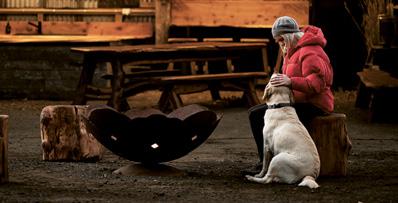





In a world of unpredictable weather and unforeseen accidents, having the right level of insurance coverage is crucial for protection and peace of mind.
The risk of not enough You’ve worked hard to buy some of your biggest assets, but do you have the right cover to protect them? Underinsurance can lead to heartbreak. In the event of a disaster, such as a fire or flood, insufficient coverage can leave you with substantial out-of-pocket expenses, potentially leading to
Start a contents inventory. You’d be surprised how fast your assets add up.
Our contents insurance provides new for old replacement, so keep that in mind. As an example, if your ten year old discontinued couch needed to be replaced, it would be replaced with today’s equivalent.
financial hardship, or the inability to rebuild your home and replace your contents. This is why it’s crucial to consider your coverage.
To help get you started, we’ve put together some tips and tricks that may help you navigate your insurance and safeguard your valuable possessions.
Consider getting your jewellery and antiques valued.
Check your renewal documents to ensure the information is accurate and your sum insured is correct.
Home and contents calculators are available at ract.com.au to help guide you to a suitable amount.
We’re urging our insurance members to check their policies regularly, and ensure cover is appropriate to your needs. To make any changes to your policy, including adjusting your sum insured, phone us on 13 27 22 or pop in and see us at one of our branches.
The information provided is general in nature and does not take into account your objectives, financial situation or needs. You should consider whether any advice is suitable for you and your personal circumstances. Before you make any decision about insurance issued by RACT Insurance Pty Ltd (ABN 96 068 167 804, AFS Licence 229 076), you should obtain and read the relevant product disclosure statement which you can find with the product target market determination at ract.com.au
59/ CHANGING GEARS
61/ STATE GROWTH
62/ MEMBER REWARDS
64/ REAR VIEW
65/ PUZZLES
66/ FAREWELL

Our pride for TasPride
RACT joins the rainbow celebrations to raise awareness for the LGBTIQ+ community
For the second consecutive year, RACT proudly supported Tasmania’s rainbow community by participating in the TasPride Parade in Hobart in February. This vibrant event, crucial for raising awareness and promoting inclusivity for the LGBTIQ+ community, saw participation numbers soar past 1000 this year, reflecting growing support. We extend our heartfelt thanks to the almost 80 RACT team members, families and friends who volunteered their time to join in on the celebration. Special recognition goes to those who journeyed from Burnie, Devonport and Launceston to stand with RACT in solidarity with the rainbow community, demonstrating our commitment to diversity and inclusivity.
For more community news, visit ract.com.au
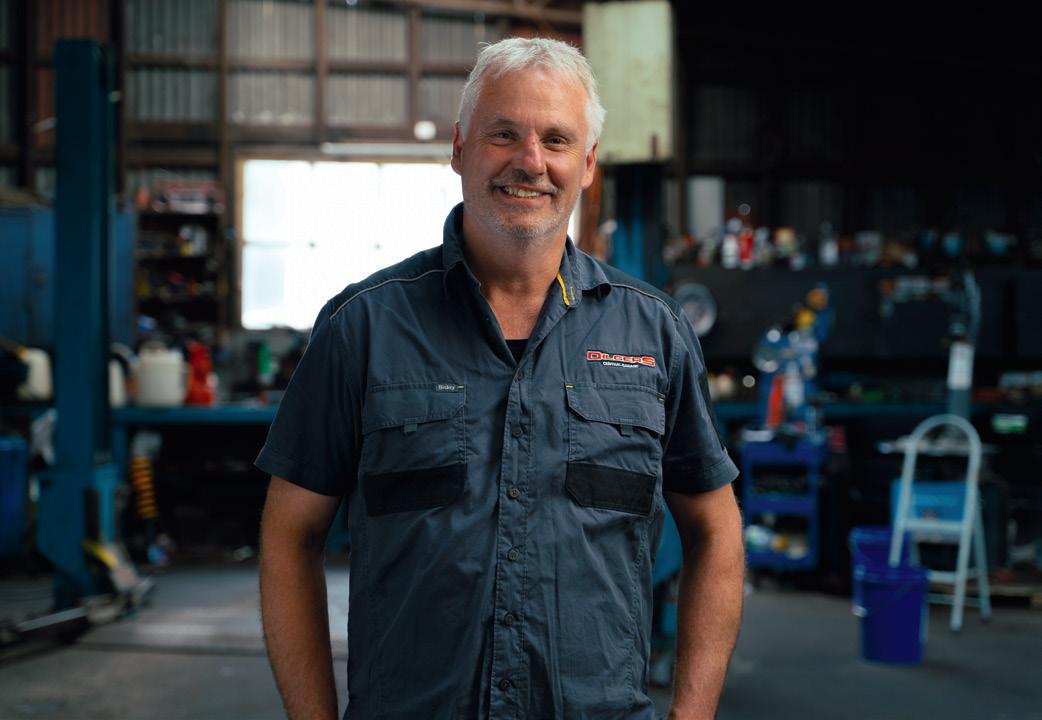
Nestled in the heart of Queenstown, Dilgers Central Garage stands as a testament to a family’s enduring legacy in Tasmania’s west coast. For 92 years, the Dilger family has been a cornerstone of the community, starting with Don Dilger, who opened the garage in 1932. This story isn’t just about a business; it’s a tale of four generations of dedication, including as RACTcontracted patrolmen, evolving with the times yet remaining steadfast in their commitment.
Imagine Tasmania in the 1930s: a landscape where the concept of a mobile phone was as distant as the moon. In those days, when a motorist broke down, they were at the mercy of the elements and the rare passing vehicle. John Dilger, reflecting on his father and grandfather’s era, paints a vivid picture: “When people broke down
on the road, they just had to sit and wait and hope that someone came past and gave them a ride in or someone went out to them. It was all hours of the day and night.”
Over the years, the landscape and methods of assistance have evolved. “It’s a bit easier to move around now. The highways are quicker, and the cars are quicker,” says John.
From repairing push bikes to servicing cars and running service stations, the journey of Dilgers Central Garage mirrors the evolution of transportation itself. John’s father, joining the family business at 12, set a precedent of dedication, a tradition John proudly continued in the early ’80s. Today, the legacy lives on with John’s sons and nephews, ensuring that the family’s commitment to the community endures.
The affiliation with RACT has woven the Dilger family into a
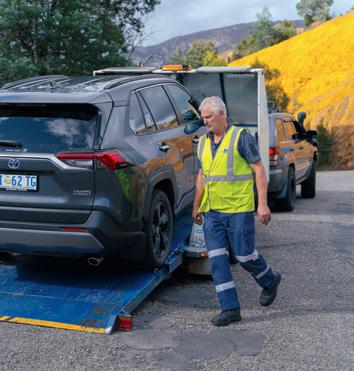
broader network, a community of support and shared values. John describes this connection with warmth, “We feel a part of a network, like a community. We do help each other out,” emphasising the benefits of RACT affiliation.
For John, being a patrolman is more than a job; it’s a calling. “It’s rewarding to get people back on the road again and get them out of a pickle,” he says.
As we celebrate RACT’s centenary, we look to individuals like John Dilger, whose stories of service, community and family weave into the rich tapestry of our history.
For the full story and videos, visit ract.com.au

Since 1923, RACT has evolved into Tasmania’s largest member organisation, marking a century of service in 2023. Let’s revisit some highlights of our centenary. Last year, we celebrated with exclusive member events, including movie screenings, garden parties and community activations, and participated in the 2023 Hobart Christmas pageant. In total 1700 members attended these events.
WE ALSO:
• Released a limited-edition coffee-table book, RACT 100 Years of Service, a nostalgic chronicle of our evolution and community impact;
• Created a dedicated 100 Years website, providing a digital platform to tell the stories of our members, staff and the community.
• Aired new TV commercials, bringing our remarkable journey to life; and
• Released a special collector’s edition of Journeys magazine, celebrating a century of stories.

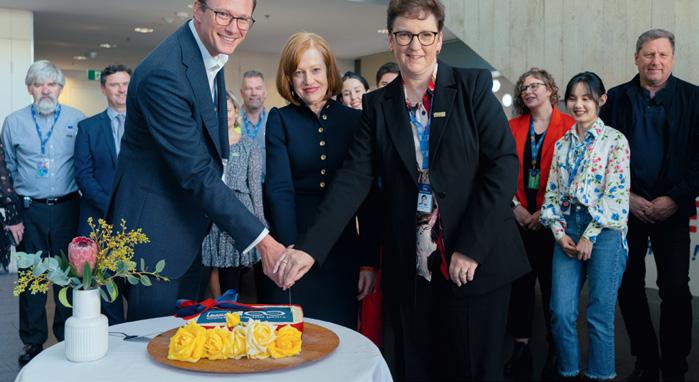


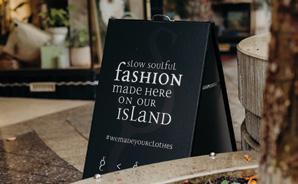
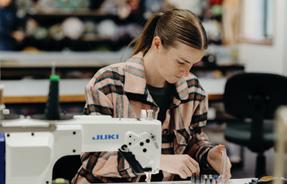




Snuggle up in front of a cosy gas log fire, relaxing on a luxurious sofa, warm cuppa in hand in awe of the Great Southern Ocean swells smashing with explosive force onto the magnificent rock formations directly in front of your retreat, just 50 metres away.
The retreats projecting outward, arrow shaped, floating on a cantilevered floor, like the bow of a ship stand solidly taking on the full brunt of the roaring forties winds. The floor to ceiling large spans of double-glazing leave nothing of the spectacle outside to the imagination, it is all real and enthralling.
Nature’s roaring 40s spectacle is intensified from June through to August and one to be experienced.

Driver education is crucial for young Tasmanians writes General Manager of Advocacy and Government Relations Melinda Percival
In Tasmania, the stark reality of road safety hits hard, especially among our youth. In the last six years, our community has been deeply affected by the loss of 44 young drivers, with more than 346 suffering serious injuries. This alarming statistic underscores a critical need: the importance of comprehensive driver education for young people.
This concern forms the backbone of RACT’s advocacy, particularly in our recent budget proposal to the Tasmanian Government. We’ve emphasised the necessity of expanding driver education programs, aiming to significantly reduce these tragic figures. Our focus isn’t just on quantity but also on reaching the heart of regional communities, where access to such programs can be a challenge.
Last year, I experienced the power of hands-on driver education at the RACT Distracted Driving Program with Glenora District High. This interactive program, a collaboration with local high schools, is a prime example of practical learning. In our dual-control vehicles, students face real-life scenarios: texting while navigating an obstacle course, experiencing vision impairment simulation with beer goggles, and coping with peer distractions in the backseat. The revelation for many was the danger posed by seemingly minor distractions.
The program’s impact has potential to go beyond the immediate reactions and instil a deep-seated understanding of and respect for road safety, vital for our young and often overconfident drivers. Inexperience, combined with the influence of peers, makes this demographic particularly vulnerable. It’s a harsh reality that we aim to change through proactive education and experiences.
Currently, the RACT Distracted Driving Program, supported by limited government funding, runs six sessions a year. Recognising the urgent need, RACT has funded additional programs. Our proposal to the Tasmanian Government seeks to further this commitment. The budget ask is not just a number – it’s a bid to safeguard our youth, to expand our reach and to make a lasting difference in the lives of young Tasmanians and their families.
Driving back from the program, a text notification on my phone became a poignant reminder of the day’s lessons. The urge to check was there, but it also reinforced the importance of the program, not just for young drivers but for all of us.
If you wish to learn more about the RACT Distracted Driving Program and our Ready for the Road initiatives, I encourage you to visit our website. By supporting these programs, we’re not just teaching driving – we’re fostering a culture of safety and responsibility on the roads, a crucial step towards a safer future for Tasmania’s youth.
1
Teach awareness of surroundings and to always be prepared to stop. This will help them to identify risks on the road quickly and increase their ability to prevent or avoid a crash.
2Be a good role model. The way you drive and behave behind the wheel will influence your learner driver.
3When getting professional driving lessons, be included in the lesson by riding along in the backseat. You’ll pick up information about the road rules and tips on how to verbally help your learner through tricky driving situations.
4Before getting on the road with your learner driver, read the road rule book to ensure you’re teaching them correctly.








asmania will take centre stage in road safety during 2024, being the host state for National Road Safety Week in May and convening the Australasian Road Safety Conference in October.
It comes at a time when every jurisdiction grapples with the challenge of reducing the number of people being killed on our roads or suffering lifelong injury as a result of road trauma.
Over the past 50 years we have made significant progress in reducing road trauma in Tasmania. Our road toll peaked in 1971, when 131 people were killed on our state’s roads. At that time Tasmania’s population was 390,000, and the rate of road deaths per 100,000 population was upward of 33.
PEOPLE
been important for improved road safety performance. And cars have become a whole lot safer too.
Today our road toll stands at around 30 people killed and a further 300 being seriously injured. Our rate of death per 100,000 population is around 6.5. These improvements have been made despite a fivefold increase in the number of vehicles on our roads.
But there’s still much work to do, especially if we’re going to achieve our short-term target to reduce the number of serious injuries and fatalities on Tasmanian roads each year to fewer than 200 by 2026.
IN 1971 ON OUR STATE’S ROADS
A number of key road safety measures have had a profound and sustained impact on making travelling on our roads safer. The compulsory wearing of seatbelts, lower blood alcohol limits coupled with random breath testing, and speed cameras have been road safety game changers. Bicycle helmet laws, 50km/h on urban streets and improved licensing arrangements for new drivers have also
Now in its 11th year, National Road Safety Week is an initiative of the Safer Australian Roads and Highways (SARAH) Group. In February 2012, 23-yearold Sarah Frazer was on her way to begin university south of Sydney when her car broke down. After pulling into the emergency breakdown lane Sarah called for assistance. As the tow-truck driver was hooking up her car, a truck sideswiped the broken-down car, killing the pair immediately.
The SARAH group was created following this tragedy by Sarah’s father
Peter Frazer, with the aim of increasing awareness of the impact of traffic death and injury, and to ask Australian drivers to take responsibility for safer driving: “Drive so others survive.”
National Road Safety Week is a collaboration between SARAH, businesses, governments, non-profit organisations, and stakeholders within the heavy vehicle and logistics industry. Running 5–12 May, it has a road safety theme for each day to highlight the tragic impact of road trauma and the ways we can all work to reduce it. Landmarks around the country will be lit up yellow to raise awareness of the devastating impacts of road trauma on our community. Look out for activities that you can become involved in as part of the week.


SAVE ON CAR SAFETY

Make sure you regularly service your heat pump to stay warm in the lead up to winter.
Save 10% on the servicing of your heat pump, hot water system or ducted system.
Go to ract.com.au/parrs-heat-pumpcentre
SAVE
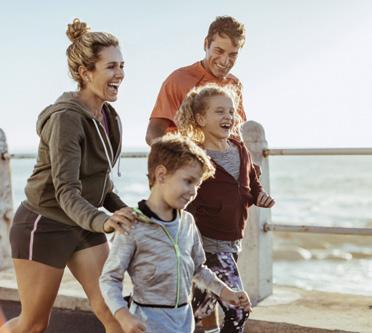
SAVE WITH HOSPITAL & EXTRAS COVER HCF
SAVE 5% SAVE $300 UP TO
Get up to $300 cashback when you take out Hospital & Extras cover with HCF.*
Go to ract.com.au/hcf

Elevate your look and make sure you can see clearly with a new set of prescription glasses from OPSM.
Save 20% on lenses and lens extras.*

Get started on your DIY ideas around the house and save with Wattyl Paints.
Save 10% on paints, stains and accessories.*
Go to ract.com.au/wattyl-paints


RAC Holiday Parks and Resorts
Heading to Western Australia for a holiday? With nine parks and resorts across the state’s coast, RAC Holiday Parks and Resorts offers plenty of accommodation options.
RACT members receive exclusive rates.
Go to ract.com.au/rac-holiday-parks-and-resorts

Do your soul and tastebuds a favour and treat yourself at this Launceston restaurant.
Save 10% on fresh, quality, locally produced burgers.*
Go to ract.com.au/burger-got-soul

Head to Gold Class to enjoy a new release and an indulgent gourmet food experience. It’s a perfect way to celebrate.
Pay $35 for Gold Class movie eVouchers.
Go to ract.com.au/village-cinemas

Get your car ready to go with plenty of deals and discounts at Repco. Save 5% every day, plus receive exclusive member offers and discounts.*
Go to ract.com.au/repco

Find the perfect place to escape and relax at RACV Resorts in Queensland or Victoria. Plus, enjoy exclusive offers on golf and spa treatments.
Save 10% at RACV Resorts.
Go to ract.com.au/racv-resorts



 CLOCKWISE FROM TOP // Magnificent sunrise at Bonnie Brach, Tamar River, by Charmaine Campbell; the bridge at Ross, by Jodie Gobbey, a close-up of Sloop Rock in Bay of Fires, by John Tait; beautiful markings left by the outgoing tide at Ulverstone beach, by Jane Potter.
Want to see your photo here? Send your shots of our beautiful island to journeys@ract.com.au or tag us with both @ractofficial and #yourjourneys on lnstagram, Facebook or Twitter.
CLOCKWISE FROM TOP // Magnificent sunrise at Bonnie Brach, Tamar River, by Charmaine Campbell; the bridge at Ross, by Jodie Gobbey, a close-up of Sloop Rock in Bay of Fires, by John Tait; beautiful markings left by the outgoing tide at Ulverstone beach, by Jane Potter.
Want to see your photo here? Send your shots of our beautiful island to journeys@ract.com.au or tag us with both @ractofficial and #yourjourneys on lnstagram, Facebook or Twitter.
Crossword
canine teeth in the upper jaw (3,5)
desktop computer (4)
21 Cautious (7)
5 Lacking flavour; weak or tasteless (7)

1 What is the full form of NFT?
2 Are bats blind?
3 Who wrote Cloudstreet?
4 What is the Australian slang for city?
5 BSoD is short for which colour of error screen?
6 How many cities does Tasmania have?
29 Do something that is beneath one's dignity (6)
1 Software that automatically displays or downloads advertising material (6)
4 A state of confusion (8)
10 Record the address of a website, file, etc (9)
Down
11 Activity that one engages in for amusement or fun (5)
1 Heat resistasnt fibrous mineral (8)
2 A subject pronoun that refers to the subject of a sentence (8)
addresses under the control of a particular organization or individual (6)
24 Hardware component that stores all of your digital content (4,5)
25 Fruit grown in Tasmania (5)
18 Member of a municipal assembly or council (8)
26 Message distributed by electronic means via a network (5)
8 Feel bitterness or indignation towards someone (6)
12 Military operation cutting off essential supplies compelling those inside to surrender (5)
13 The action of becoming larger or more extensive (9)
14 Control the functioning of a machine (7)
3 Vegetable fibre noted for its length and toughness (5)
16 Flat, thin circular object (4)
19 A brand of an all-in-one
5 Lacking flavour; weak or tasteless (7)
6 Person who arranges an event or activity (9)
7 A distinct subset of
27 A variety of floating brown seaweed (9)
28 Either of the two canine teeth in the upper jaw (3,5)
9 A broad horizontal band of sculpted or painted decoration, especially on a wall (6)
6 Person who arranges an event or activity (9)
7 A distinct subset of the internet with addresses under the control of a particular organisation or individual (6)
20 Items that extends the interfaces between all of the components of a motherboard (7)
29 Do something that is beneath one’s dignity (6)
8 Feel bitterness or indignation towards someone (6)
9 A broad horizontal band of sculpted or painted decoration, especially on a wall (6)
21 Happy and optimistic (6)
15 Mammal that has large claws for digging and a body covered in bony plates (9)

7 Carrots are particularly rich in which vitamin?
8 In which country was Pablo Picasso born?
9 Which company rebranded itself as “Meta” and in what year?
10 What was Miley Cyrus’s birth name?
1 Heat-resistant fibrous mineral (8)
2 A subject pronoun that refers to the subject of a sentence (8)
15 Mammal that has large claws for digging and a body covered in bony plates (9)
22 Breathe with a whistling or rattling sound in the chest (6)
17 Away from prepared ski runs (3-5)
18 Member of a municipal assembly or council (8)
3 Vegetable fibre noted for its length and toughness (5)
20 Items that extends the interfaces between all of the components of a motherboard (7)
17 Away from prepared ski runs (3-5)
23 Elaborately or highly decorated (6)
25 Mouth wide open in surprise or wonder (5)
Want to find out how you did? Find the answers online at ract.com.au/puzzles




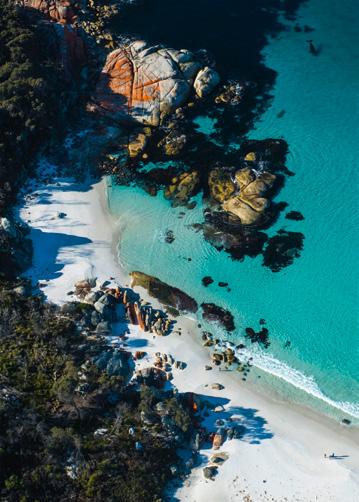

The pages of Journeys have been enriched by the stories and insights of writer/ photographer Chris Crerar for several years. His regular contributions showcased a unique talent and a deep curiosity about the world around him. Today, we remember Chris, whose sudden passing has left a significant gap in our Journeys family.
After starting his career in the newspaper industry as a photographer, Chris seamlessly moved into photojournalism. His dedication to sharing stories through both images and words was evident in every piece he created. Chris was driven by a desire to connect with readers and highlight the diverse experiences and landscapes that make our island so special.
Chris’ father, Bruce, fondly remembers him as a “rollercoaster” – a spirit always in pursuit of the next challenge, relentlessly pushing the boundaries of what was possible within the confines of a day. For Chris, the notion of ‘enough time’ was foreign; there were always more stories
to tell and more of Tasmania’s beauty to uncover.
A passionate advocate for social justice, Chris’ passion for the rights of Tasmania’s First Nations people stood out. His work not only shed light on critical issues but also encouraged dialogue and understanding, embodying the very essence of advocacy through storytelling.
Chris’ legacy is carried forward by his parents, Bruce and Pam, and the entire Crerar clan, including Adam and Vaughan; Jackie and Tamara; Suhela and Rosita.
As we remember Chris, we do so with deep appreciation for the stories he shared and the impact he made. His work has left a permanent mark on Journeys and its readers. Chris’ voice and his commitment to storytelling and justice will continue to resonate with us.
Chris’ passing is a sorrowful reminder of the struggles that often remain unseen. In his memory, we encourage anyone facing personal battles to seek support and remind them that they are not alone.
For support, visit beyondblue.org.au


